Bus & Tram Journeys Multiple bus rides made in a one hour period count as a single bus journey.
Tube & train journeys.
Your fare is

JavaScript is disabled
Please enable JavaScript in your browser in order to use OysterCalculator.

Easy London Budget Calculator: How Much Does it Cost to Visit London?
How much does it cost to visit London? That all depends.
A lot of estimations out there are outdated, have the wrong average prices for hotels, and don’t factor in things like what attractions you want to see or what your dining style is.
Plus, a London trip budget pre-pandemic looks a lot different from a London trip budget post-pandemic. Prices have changed dramatically.

To give you a better idea of your real London trip budget, I’ve created a London budget calculator for you using the most up to date pricing.
Take it from someone who lives here and spends (too much) everyday: sticking to a budget in this city is hard but it can be done!
I want you to be able to visit our incredible city with a realistic sense of how much things cost and make the most out of your time and money here.
Let’s calculate your London trip budget!
London Budget Calculator for 2024
Use the London budget calculator below, and read on to find out how I came up with these figures and how to save the most money.
Keep in mind these are estimated figures and it’s only to give you a realistic idea of how much things will cost.
Your total spend in London may be more or less because there are so many factors that I can’t include all of here.
How Much Does it Cost to Visit London in 2024?
To create my London budget calculator, I pulled real-life, current 2023 prices for everything from attractions to hotels from their actual websites.
For figures where I needed averages, I analyzed a sample of current prices and came up with the most accurate average price I could.
Below may contain some affiliate links, for which I may receive. small commission if you make a purchase. It doesn’t cost you anything extra!
Accommodation Cost in London
Looking for the average cost of accommodation in London, I came away unsatisfied. The numbers looked too low to me, so I did my own research and analyzed the data.
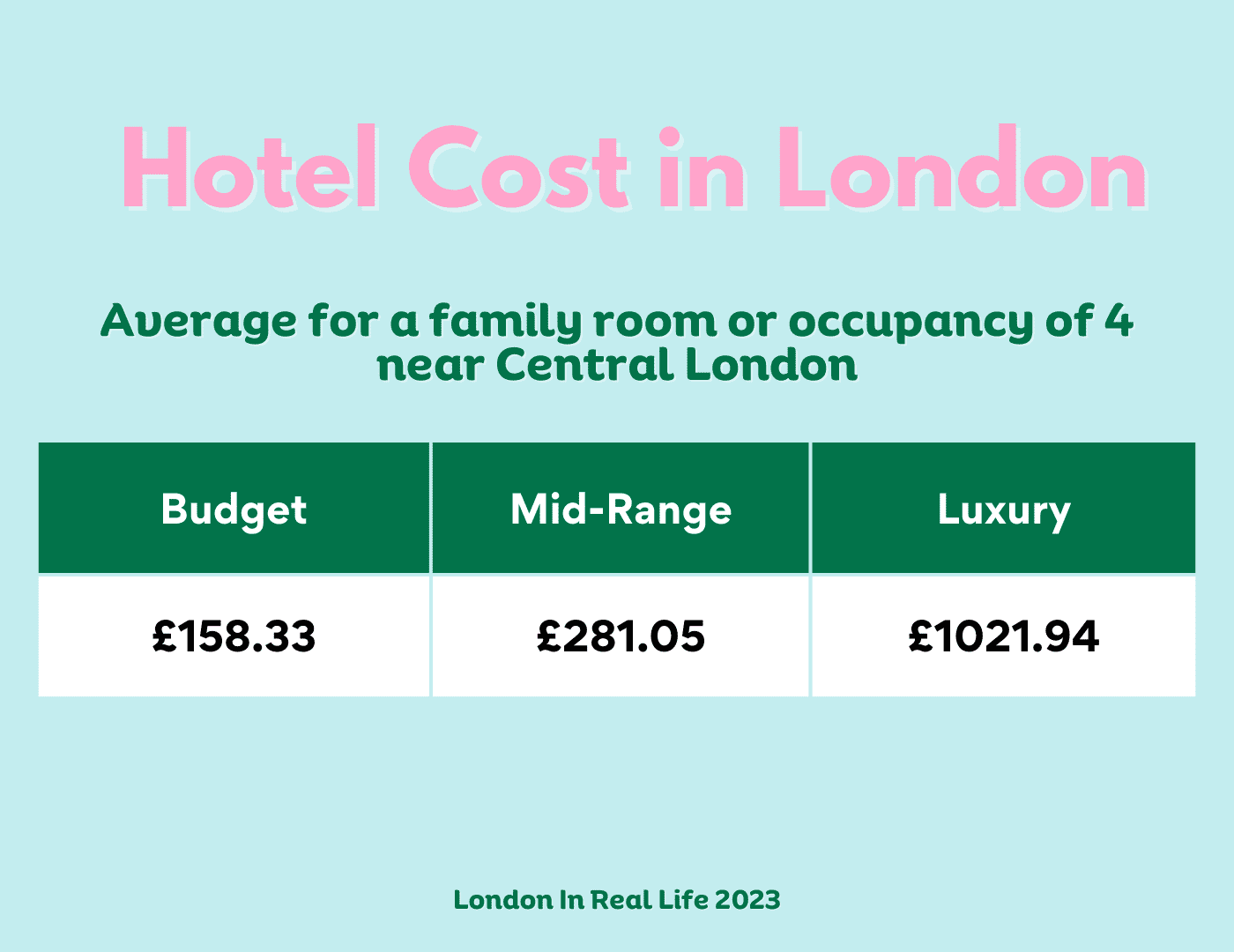
To calculate the average prices of Airbnbs and hotels in London, I needed real figures of actual listed properties. So I took a sample from each category, ran the numbers, added average fees, and came up with a good representation of the average cost.
You can see my full breakdown of the average costs of hotels and Airbnbs in London in my post here.
What’s the Average Cost of Airport Transport in London?

To calculate the average cost of private airport transfers in London, I sampled prices from Uber and several private car companies that you can book ahead.
- Average price of Public Transport from London Airports (not calculated in above calculator; add to total if you’re using this method): £12.50pp (Underground) – £25pp (Express trains)
- Average price of UberX from London Airports: £60
- Average price of private car from London Airports to Central London: £120
- Average price of private van or people carrier from London Airports to Central London: £200
🤑 Money Saving Tip:
Take public transport from London airports ! It’s so much cheaper, plus fast and efficient.
The only time I wouldn’t do this is if you are a large family with a lot of luggage. Navigating the tube or trains with lots of bags isn’t ideal, as not everywhere has step-free access and lifts.
What’s the Average Cost of Daily Transportation in London?

Daily transportation costs within London can vary widely depending on which method of transportation you want to use.
I needed to do a little estimating here, as the cost of Uber, taxis, and private cars totally depends on how far you’re going, what traffic is like (bad, generally) and which company you use.
For public transport, prices are divided by zone and capped per day depending on how many zones you travel through, though most tourists don’t generally go outside of Zone 3.
- Average cost of public transport per person per day: £9 ( using an Oyster card or contactless payment method)
- Average cost of using some public transport and some private (some Uber or Taxis per person per day): £25
- Average cost of using only private transport (taxis & Uber only) per person per day: £60
🤑 Money Saving Tip:
Use public transport in London! It’s fast, efficient, and completely affordable. Use CityMapper or Google Maps to get easy to follow instructions from place to place.
What’s the Average Daily Food Cost in London?

Other than accommodation, food may be your second largest expense in London.
I’m not going to lie: I cringe at our grocery and restaurant bills in London. But there are ways to keep it affordable.
To pull real data, I created a bunch of sample checks from real London cafes, restaurants, grocery stores, pubs, and coffee shops.
I also went through my own family expenses for food, and averaged all of these numbers out to a rough estimation.
- Average daily cost of budget dining in London (sticking to only fast-type food, grocery stores, and cheap restaurants and takeaways. Not including alcohol): £26 per person
- Average daily cost of mid-range dining ( some cheap restaurants, some more expensive, not including alcohol ): £55pp
- Average daily cost of fine dining ( not including alcoho l): £130 pp
Picnics are your very best friend in London to keep eating affordable.
UK grocery stores have a much larger selection of prepared foods than other countries do, so it’s quite easy (and cheap!) to pop into a grocery store and create your own ready-to-eat meal. Take it to a park and have a lovely lunch!
For restaurants, stay off the high street . In touristy areas, go away from the crowds to find hidden gems, or enjoy a lovely food hall.
If you want to experience afternoon tea, here’s my full list of afternoon tea on a budget options!
London Trip Budget: Attractions and Day Trips
In my London budget calculator I have plugged in the current 2024 per person attraction ticket prices. Children’s tickets are usually only a few pounds less.
For the London Eye, for example, adult tickets are £38 and children’s are £34. Not much difference.
Keep in mind that there are so many attractions and museums in London that are totally free! These are just the most popular paid attractions you might want to see.
For day trips , I have found prices from tour companies that offer these day trips including transportation.
It may be cheaper if you book your own trains and navigate these day trips on your own.
🤑 Money Saving Tip
Take advantage of all of the free museums that London has to offer! Consider booking day trips yourself and not using a tour company to save the most cash.
You can also potentially save money on attractions using the London Pass or similar program.
London Trip Budget: Final Tips
How much does it cost to visit London? I hope if you’ve used my London budget calculator you now have a better idea of how much you’ll need to visit our incredible city.
Keep in mind that accommodation cost in London will by far be your biggest expense, but there are tons of ways to maximize your hotel or Airbnb budget.
More on Budgeting for London
31 Costly London Tourist Mistakes & How to Avoid Them
Is the London Pass Worth it? Analysis & Easy Calculator
What NOT to do in London: The Truth About these 15 Tiring Tourist Traps
Is Tipping in the UK Expected? A Super Simple Guide
Is the London Pass Worth it? Use the Calculator
Your Ultimate Guide to a Family Trip to London on a Budget
The Perfect Ladies Day Out in London: 3 Itineraries for Every Budget
The Best Thrift Shops in London: 7 Areas to Score the Best Second Hand Bargains
What’s the Closest Country to London? 10 Incredible Trips to Take Today
Similar Posts

Visiting Battersea Power Station: Everything You Need To Know (2024)
Wanting to visit Battersea Power Station? I have all the details for you to make the most of your visit, no matter your budget.

How to Use Google Maps in London: A Simple Beginner’s Guide
Learning how to use Google Maps in London can start off confusing, but with a few simple steps, you can learn how to travel London with ease.

19 Hidden Gem Hotels in London Voted on By Frequent Travelers
Frequent London travelers told me their favorite hidden gem hotels in London. Here are their answers!

Exactly How to Spend 5 Days in London: Free Itinerary
Here’s exactly how to spend 5 days in London, from a local guide.

Expert’s Easy Itinerary for 3 Days in London
Here’s a Londoner’s easy itinerary for 3 days in London. See the best bits, grouped together for easy travel.

21 Best Nicknames for London and England That People Actually Use
There are so many nicknames for London and nicknames for England…but which ones do people still use today?

- Places to Visit
- Sightseeing
- Practical Tips
- Where to Stay
London Underground Tickets & Travelcards
The Travelcard is a transport pass for London that gives you unlimited travel in London within certain zones . The prices vary according to the number of zones you need to travel through. Central London is in zone 1.
Travelcards are valid for 1 day, 7 days, 1 month or 1 year.
The passes are valid for travel on all types of transport in London including:
- the Underground (the tube)
- the local suburban trains within London
- the Elizabeth Line (not west of West Drayton)
- the Docklands Light Railway (DLR)
- the London Overground
- the buses all over London. A Travelcard for any zone allows you to use the buses in all zones (zones 1-6)
The 3 Day Travelcard, weekend Travelcard, Zone 1-2 & 2-6 One Day Travelcards are no longer available.
Visiting London for 1-7 days? See our guide to London’s transport tickets & passes . The Travelcard may not be the best ticket for your stay.
Single Underground Tickets
Single paper tickets on the London underground are expensive if you buy them from a tube station ticket machine:
- £6.70 for one journey in zone 1 (central London) and between zone 1 and zones 2 to 6
- See single ticket prices for all zones .
One Day Travelcards: 2024 prices
Using a Pay as you go Oyster card or a contactless card are the cheapest ways to pay for travel if you’re in London for 1-5 days. The daily cap is £8.50 per day for zones 1-2
If you really don’t want to use an Oyster card or don’t have a contactless card, the One Day Travelcard is the next best money-saving pass.
The paper Off peak One Day Travelcard for zone 1-6 is £15.90. This is expensive, but still cheaper than paying the full cash fare for 3 underground trips in central London (3 x £6.70 = £20.10 ).
One Day Travelcard fares from 3 March 2024
Peak v anytime travelcards.
One Day Travelcard prices are different if you travel during peak or off-peak times:
Anytime Travelcard Valid for travel at anytime. Off-Peak Travelcard For travel after 9.30am Monday–Friday and all day Saturday, Sunday and public holidays.
Top Tip: An Off-Peak One Day Travelcard for zones 1–6 costs £10.40 with a Railcard .
Weekly Travelcards: 2024 prices
If you stay in London for 6–7 days and use the underground, trains, and buses every day, the weekly Travelcard is the most cost-effective travel pass.
The one-week pass including central London (zones 1-2) is £42.70.
- It can start on any day of the week
- It’s valid for travel at anytime; there is no peak or off-peak rate.
Most places sell weekly Travelcards loaded onto a plastic Oyster card. There’s a £7 fee for the Oyster card.
Your fare on an Oyster card will automatically cap at the weekly Travelcard fare (this is already available on contactless cards). The cap starts on Monday and ends Sunday, so it mainly benefits Londoners or those working in London.
Weekly Travelcard fares from 3 March 2024
- See weekly Travelcards prices for all other zones (2, 3, 4, 5 and 6)
Monthly Travelcards: 2024 prices
For longer stays in London, monthly Travelcards are available. You won’t save much compared to buying 4 x weekly Travelcards – but you’ll save time renewing it. Like the weekly Travelcard, it can start on any day of the week and is valid for travel at any time. See monthly Travelcard prices for all other zones (2, 3, 4, 5 and 6)
Monthly Travelcards from 3 March 2024
Where to buy travelcards.
One day, weekly and monthly Travelcards are available from:
Underground stations
Travelcards are available from all underground station ticket machines (there are no longer any underground tickets offices). The busier stations in central London have staff to help you use the machines.
Local shops and newsagents
Travelcards are also available from Oyster ticket stops . These are newsagents and local shops licensed to sell London transport tickets and Oyster cards. One Day Travelcards are not available from Oyster ticket stops.
London train stations
One Day Travelcards are available from all London train station ticket offices and ticket macines. Paper weekly and monthly Travelcards are no longer available from train stations . They are available to buy, but they are loaded onto an Oyster card and may only be available from ticket machines, not ticket offices.
London Transport Visitor Centres
TfL Visitor Centres at Victoria train station, Kings Cross/St Pancras International station, Heathrow Terminal 2 & 3 tube staion, Liverpool St station & Piccadilly Circus tube station.
How to use a Travelcard
On the underground.
If you have a paper One Day Travelcard or single ticket from a ticket machine, insert the card into the slot on the front of the ticket barrier. The barrier opens when you take the ticket from behind the yellow reader, on the top.
If you have a paper One Day Travelcard, just show it to the driver when boarding the bus.
See How to use an Oyster card if you have a weekly Travelcard on an Oyster card.
Top Tip: Do you want a cheaper way to travel around central London? If you only travel by bus , it costs £5.25 per day or £24.70 per week.
Related pages
- Guide to London’s transport tickets
- Weekly and monthly Travelcards for zones 2, 3, 4, 5 & 6
- Oyster card
- How to use a contactless card to pay for transport
- Bus tickets & passes
- London Transport zones
Last updated: 22 February 2024
Transport tickets & passes
- Guide to London's transport tickets
- One day & weekly Travelcards
- Zone 2–6 weekly Travelcards
- Bus tickets & passes
- Oyster single tickets
- Oyster card refunds
- Contactless cards
- Child tickets & passes
- Local train tickets
Useful information
- Plan your journey
- London transport zones
Popular pages
- Left luggage offices
- Congestion Charge
- 2 for 1 discounts at London attractions
- Oyster cards
- Top free museums & galleries
- Cheap eating tips
- Heathrow to London by underground
Copyright 2010-2024 toptiplondon.com. All rights reserved. Contact us | Disclaimer | Privacy
Cost of Living Estimator in London, United Kingdom
Currency: EUR USD --- AED AFN ALL AMD ANG AOA AUD AWG AZN BAM BBD BDT BGN BHD BIF BMD BND BOB BRL BSD BTN BWP BYN BZD CAD CDF CHF CLF CLP CNH CNY COP CRC CUC CVE CZK DJF DKK DOP EGP ERN EUR FJD FKP GBP GEL GGP GHS GIP GMD GNF GTQ GYD HKD HNL HRK HTG HUF IDR ILS IMP INR IQD IRR ISK JEP JMD JOD JPY KES KGS KHR KMF KPW KRW KWD KYD KZT LAK LKR LRD LSL LYD MAD MDL MGA MKD MNT MOP MRU MUR MVR MXN MYR MZN NAD NIO NOK NPR NZD OMR PAB PEN PGK PHP PKR PLN PYG QAR RON RSD RUB RWF SAR SBD SCR SDG SEK SGD SHP SLL SOS SRD STD STN SVC SYP SZL THB TJS TMT TND TOP TRY TTD TWD TZS UAH UGX USD UYU UZS VES VND VUV WST XAF XAG XCD XDR XOF XPF YER ZAR ZMW ZWL Sticky Currency
Members of your household:
Eating lunch or dinner in restaurants: 0.0% 2.0% 5.0% 10.0% 20.0% 30.0% 40.0% 50.0% 60.0% 70.0% 80.0% 90.0% 100.0% of the time
When eating in restaurants, you are choosing inexpensive restaurants: 0.0% 10.0% 20.0% 30.0% 40.0% 50.0% 60.0% 70.0% 80.0% 90.0% 100.0% of the time
Drinking Coffee outside of your home: A lot High Moderate Low No
Going out (cinema, nightlife, etc.): none very low (twice per month per household member) low (three times per month per household member) average (once per week per household member) high (twice per week per household member) very high (3-4 times per week per household member)
Smoking (household overall): packs of cigarettes per day
Alcoholic beverages (consume): A lot Moderate Low No
At home, we are eating: Western Asian food
Driving car: A lot Moderate Low No
Taking Taxi: Daily one round trip Two round trips per Week One round trip per Week One round trip per Month No
Paying for public transport tickets: Monthly, All Members Monthly, 2 Family Members Monthly, 1 Family Members On-Demand, around 5 round trips weekly per family member On-Demand, around 4 round trips weekly per family member On-Demand, around 3 round trips weekly per family member On-Demand, around 2 round trips weekly per family member On-Demand, around 1 round trip weekly per family member None
Sport Memberships: All Household Members 1 Household Member 2 Household Members No
Vacation and Travel: Three per year (one week each), relatively expensive Two per year (one week each), relatively expensive Once per year (one week each), relatively expensive Twice per year (one week each), relatively inexpensive Once per year (one week each), relatively inexpensive None
Buying Clothing and Shoes : A Lot Moderate Low
Rent: none Apartment (1 bedroom) in City Centre Apartment (1 bedroom) Outside of Centre Apartment (3 bedrooms) in City Centre Apartment (3 bedrooms) Outside of Centre Sharing a Room in 3 Bedroom apartment City Centre Sharing a Room in 3 Bedroom apartment Outside of Centre Mortgage for 1 bedroom apartment (approximate) Mortgage for 3 bedroom apartment (approximate)
Number of your children going to kindergarten:
Number of your children going to the private school:
* Our estimator doesn't include insurance, health-related expenses, parking fees, or domestic help. It doesn't take into calculations income tax.
Copyright © 2009-2024 Numbeo. Your use of this service is subject to our Terms of Use and Privacy Policy
Travel Europe on a Budget
The Savvy Backpacker
City Guides .\33 a132798-3f3b-4585-954d-7e70cf863447{fill:#231f20}
London price guide | calculating the daily costs to visit london.
How to estimate your budget for food, hostels, hotels, attractions, alcohol & more for visiting London on a budget.

London is a world-class city but It’s also one of the most expensive cities in the world. Luckily, hostels are reasonably affordable (at least for a major city) and there are plenty of great free museums. However, the cost of attractions and food prices will put a major dent in your budget.
In this London travel price guide, we’ll outline the estimated travel expenses for food, accommodation, attractions, alcohol, and other things that you’ll experience so you can better budget your trip to London.
This London Price Guide is part of our City Price Guide Series where we break down the travel costs of Europe’s most popular cities.
Average Daily Cost For Visiting London
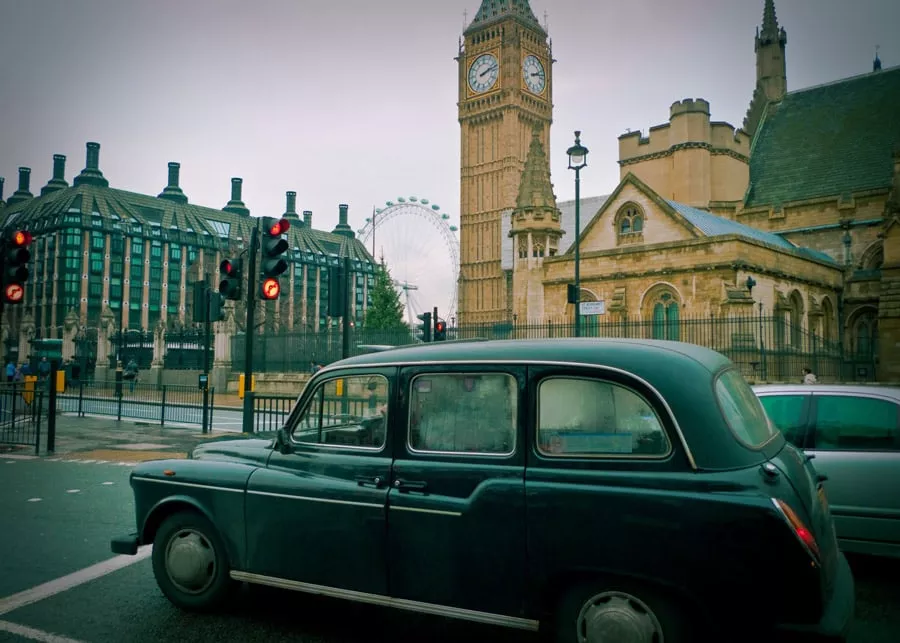
It costs around £60-£95/day ($75-$115) to visit London comfortably as a budget traveler. These prices are based on what you’ll need to visit the city comfortably as a budget traveler.
If you want to upgrade your accommodations, add another £40-£100/night depending on your stay. These prices also don’t include things like big nights out at the bar/pub, club entry fees, souvenir/clothing shopping, tours, random purchases, nicer food, etc.
Daily Cost of Budget Travel in London: £92 (Approx. $115)
- Attractions: £20 (one paid attraction + any free museums)
- Breakfast: £4
- Dinner: £15
- Treat (dessert/beer/wine): 4
- Transportation: £8
- Accommodation (hostel): £33/night
Daily Cost of Frugal Travel in London: £57 (Approx. $70)
- Attractions: £10 (visit one of the many free museums and do a free tour)
- Breakfast: £2
- Lunch: £6 (ethnic street food or takeaway shop fare)
- Dinner: £10 (cook your own meal in the hostel or cheap takeout)
- Transportation: £2.30 (single tube ride)
- Accommodation (cheap hostel bed): £23/night
London Attraction and Museum Prices
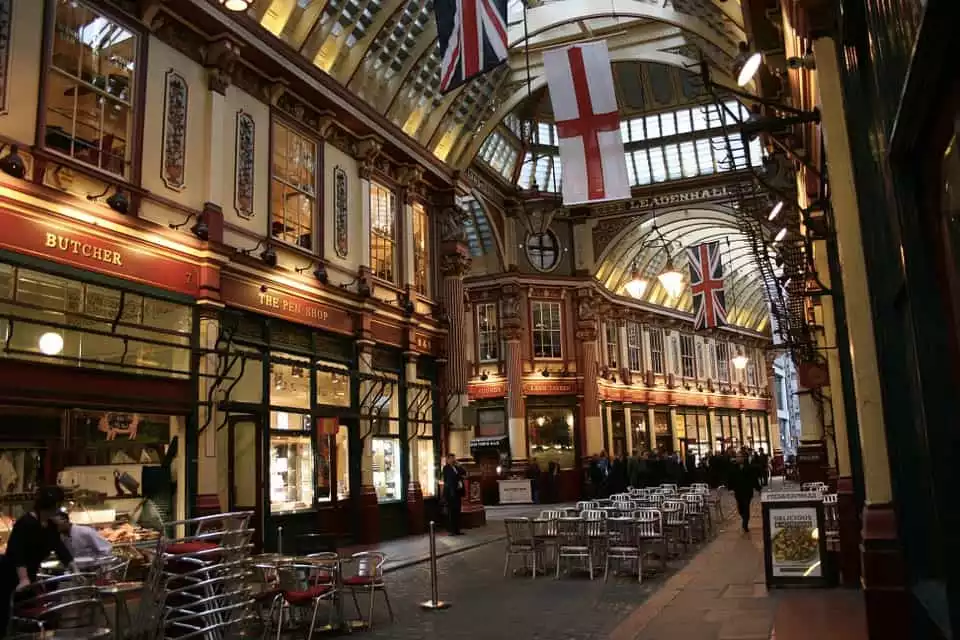
Good news… London has amazing museums and most of them are completely free. Bad news… all the other attractions are expensive. However, you might be able to save some money by using the London Pass if you plan on visiting multiple attractions. Read our London Pass Review for more information.
- Tower of London : £29.90
- London Eye : £31-£53
- St. Paul’s Cathedral : £20.50
- Buckingham Palace : £30-£33
- Westminster Abbey : £27.00
- British Museum : Free
- Victoria and Albert Museum : Free
- National Gallery : Free
- Imperial War Museum : Free
- Tate Modern : Free
- Natural History Museum : Free
- Walking Tours: Free (but you should tip the guides) — £20+
Tip: Many attractions now offer online booking and there is often a small discount for booking online vs buying tickets at the door (and you get to skip the ticket line).
London Food Prices

England isn’t traditionally known for great food but London does have a world-renowned food scene—but that high-end food is a budget killer. Budget travelers will have to stick to the basics, and even then, the food isn’t cheap. If you’re on a tight budget, you might want to cook for yourself as much as possible.
Check out The Savvy Backpacker’s Guide To London On A Budget because it has a ton of great budget-friendly restaurants.
Budget Breakfast Prices in London: £ 3-£10
- Many hostels will offer a free, simple breakfast that normally consists of cereal, bread/croissant, and maybe milk, coffee, tea, or juice (some hostels will offer more and some less).
- A traditional English breakfast from a typical café will cost £6-£9.
- You can also find plenty of budget-friendly options at the bakery or grocery store. Croissants and other baked goods start at around £1.50. Coffee from a typical café will cost around £2.50-£4.
Budget Lunch Prices in London: £5-£15
- Super-budget travelers can make a super cheap lunch of bread, cheese, and fruit from any grocery store for a few pounds.
- Takeaway meals (like kebabs with fries) or similar dishes from a takeaway shop will cost about £7-£9.
- Check out street markets for pizza, falafel, tagines, burritos, curries, wraps, and sandwiches for £5-£9.
- A simple, yet filling and tasty, lunch from a local (i.e. non-touristy) restaurant will cost about £10-£15.
Budget Dinner Prices in London: £7-£18
- Budget travelers will want to seek out the many ethnic restaurants in London. It isn’t too tough to find a good meal for about £12-£18.
- McDonald’s combo meal (burger, fries, and a drink) will cost about £7.
- Fish and chips from a quality fish and chips shop will cost around £8-£12 for takeaway and a bit more to dine in.
- A simple, yet filling and tasty, meal from a local (i.e. non-touristy) restaurant will cost about £12-£18.
- Many of the options from the Budget Lunch section above also apply to dinner.
Drinks and Alcohol Prices in London
- Pint of standard beer out: £3.20-£6+
- Pint of beer from a grocery store: £1-£2
- A glass of the house wine at a restaurant: £4-£5+
Local-Favorite Budget Restaurants in London:
Here are a few budget restaurants that I pulled from our Guide To London On A Budget .
FISHCOTHEQUE
This traditional hole-in-the-wall joint is tucked under a bridge and serves up generous portions for a reasonable price. They’re a local favorite so it can get busy during lunch and dinner.
- Order of Fish and Chips: £15-£18
- See On Google Maps
Opened in 1982, this bustling award-winning shop serves up some of the best traditional fish and chips in London. Dine-in or takeaway.
- Order of Fish and Chips: £10-£14
GIGS FISH & CHIPS
Opened in 1958, Gigs obviously knows what they’re doing if they’ve survived this long in a city that seems to have a chippy everywhere you look.
- Order of Fish and Chips: £9 (takeaway) – £14.50 (dine-in)
- See on Google Maps
REGENCY CAFE
Cheap, no-frills, delicious, and always busy (get there early to avoid a long wait). This authentic spot has been around since 1946 and is a local favorite.
- Full English Breakfast: Starts at £6.00
TERRY’S CAFE
Old-school, family-run cafe. Quality food for a good price. A local favorite since 1982.
- Full English Breakfast: Starts at £8.50-£12
Expect long lines and excellent Bombay-style comfort food at this popular restaurant. The prices are fair, the atmosphere is buzzing, and the quality of food and drinks is excellent. Many people say this is their favorite Indian restaurant in London.
- Main Dishes: £9-£15
Solid Italian-style pizza at a solid price.
- Prices: £5.50-£8.50
GODDARDS AT GREENWICH (BRITISH)
This traditional pie mash restaurant has been around since 1890 and they serve up handmade pie & mash daily at a fair price. They have some nice traditional British desserts as well.
- Main Dishes: £5.50-£9
SÔNG QUÊ CAFÉ (VIETNAMESE/PHO)
Excellent Vietnamese place to get authentic beef pho at a great price. Super popular so expect a line.
- Main Dishes: £7.50-£10
London Transportation Prices
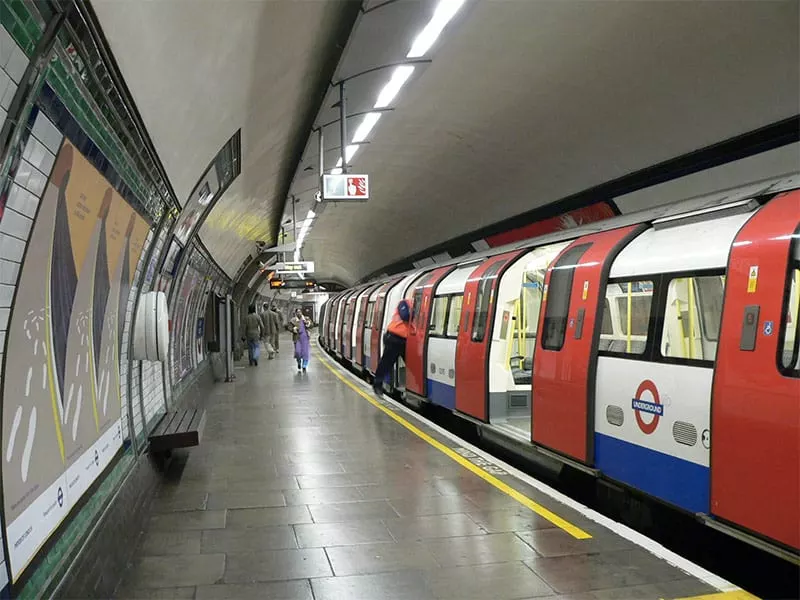
London is a big city so you’ll need to use public transportation a few times during your visit. Unfortunately, it can be kind of expensive and it can be a bit confusing because London has multiple travel zones which determine the price.
You should use an Oyster Card (a refillable travel card) or contactless payment as these methods greatly reduce the ticket price vs buying a single one-way ticket.
- Single One-Way Ticket: £6.30
- Single One-Way Fare with Oyster Card: £2.80 (peak), £2.70 (off-peak)
- Max Day Fare: £8.10 (you’ll never pay more than £9.10 in a single day when using the Oyster Card)
- Heathrow Express (fast train between LHR and London— travel time 15min): £22.50-£25
- London Underground (between airport and city — travel time 60min): £5.70
- Heathrow Connect (30min journey): £10.30
- Bus from LHR airport into the city (60-80min): £6-£10
- Taxi LHR airport into the city: £50 – £70
London Hostel, Hotel, & Rental Apartment Prices
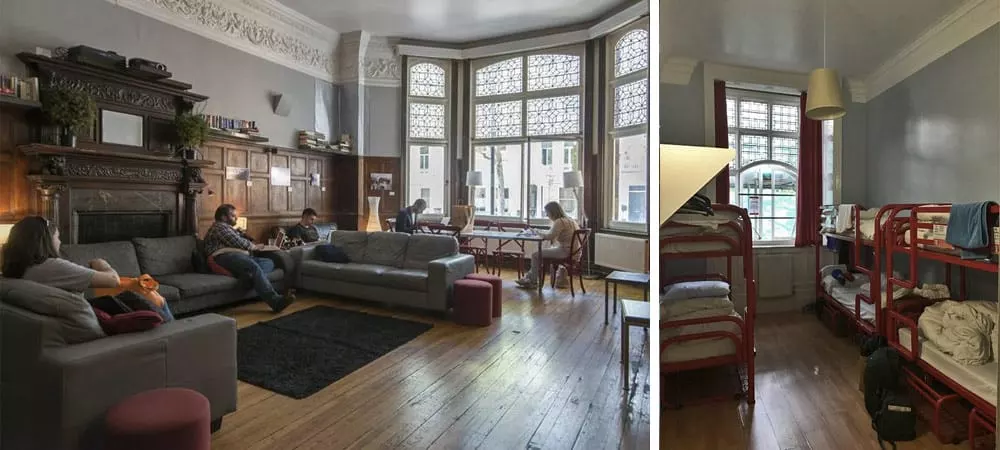
London has plenty of hostels throughout the city and all the competition helps lower hostel prices—but you still shouldn’t expect cheap prices. Don’t expect much from budget hotels as most are small, rundown, and dingy. Apartment rentals can be a very attractive option if you’re traveling with two or more people.
Hostel Prices in London: £23-£47/night
The nightly price of a well-rated hostel in London starts around £30 per person—although many hostels raise their prices on the weekend. Remember, these prices are for a bed in a shared dorm room. Private rooms start are around £110-£160/night. Check out the latest London hostel prices at Hostelworld .
Here is a list of the top-rated hostels in London:
- Wombats City Hostel London
- Astor Hyde Park
- Astor Queensway
- Barmy Badger Backpackers
- MEININGER London Hyde Park
Check out The Savvy Backpacker’s guide to The Best Hostels in London to get a more in-depth look at London’s various hostel options.
Budget Hotel Prices in London: £90-£150 /night
Budget hotels in central London start around £70-£95/night but the quality will be low. A well-rated budget hotel in London starts at around £130-£145/night. Prices do rise if you book last minute—especially during the summer and Christmas.
We suggest checking out Booking.com to see hotel prices for your dates since they’re always changing.
Rental Apartment Prices in London: £90-£170+ /night
London has a lot of rental apartments throughout the city. They can be a good option for large groups or travelers who want a little more space (and a kitchen). On the other hand, you may also have to deal with inconvenient check-in processes and things like extra cleaning fees and service charges. For short stays, we prefer hotels/hostels but rental apartments can be a nice option for longer stays. Airbnb is always popular but you can sometimes find cheaper/better options on our list of Airbnb Alternatives .
LEARN MORE ABOUT EUROPE TRAVEL COSTS
Check out our guide on How Much It Costs To Backpack Europe to learn more about budgeting your entire trip (including many more city price guides).
Be sure to also check out our London Travel Guide and our Guide to London on a Budget for more London travel tips.

- Recent Posts
- Best Prepaid UK eSIM | Data Plan Buyer’s Guide - April 21, 2024
- How to Avoid Pickpockets in Europe — Tips for Outsmarting the Thieves - April 19, 2024
- Best Prepaid eSIM For Italy | Data Plan Buyer’s Guide - April 18, 2024

No Funny Business
The Savvy Backpacker is reader-supported. That means when you buy products/services through links on the site, I may earn an affiliate commission—it doesn’t cost you anything extra and it helps support the site.
Thanks For Reading! — James
Questions? Learn more about our Strict Advertising Policy and How To Support Us .
Related Reads
A backpacker’s guide to the best hostels in london | london hostels.
The best hostels in London based on amenities, price, location, and overall quality.
Guide To London On a Budget | How To Save Money in London
How to visit London on a budget — what to do, see, and eat for cheap!
London Travel Guide | The Ultimate Guide To London
The best things to do, see, and eat in London.
London Pass Review
Wondering if the London Pass is worth the price? Check out our in-depth review of the London Pass and analysis of its value.
City Guides
Choosing travel insurance, travel packing lists, budget travel newsletter.
The best budget travel tips sent straight to your inbox.
Join My Journey
Europe travel tips, advertising & privacy policies.
TheSavvyBackpacker.com is a participant in the Amazon Services LLC Associates Program, an affiliate advertising program designed to provide a means for sites to earn advertising fees by advertising and linking to amazon.com.
© 2010 - 2024 The Savvy Backpacker
Website Design by FHOKE
Calculating Monthly Transportation Costs For Living In London
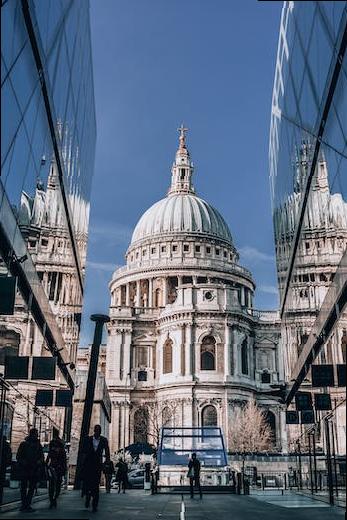
Transportation expenses are an essential component of the cost of living in any city, and London is no exception. As one of the world’s most visited and bustling cities, transportation in London is a vital aspect of daily life. With a vast public transportation network serving both the city and its suburbs, it can be challenging to determine how much one should budget for transportation expenses when planning to live in London.
To live comfortably in London, one must consider the cost of public transportation, including buses, underground trains, and overground trains. The cost of a single journey on the London Underground varies depending on the zones travelled through, with prices starting at £2.40 for a single fare in Zone 1. Meanwhile, bus trips start from £1.50 for a single journey, while overground trains cost £1.80 at off-peak times within Zones 1-3.
Additionally, London’s famous black cabs and ride-sharing services are more expensive modes of transportation. Black cabs’ fares and prices for ride-sharing services differ and depend on several factors, including the distance travelled, traffic congestion, and peak hours.
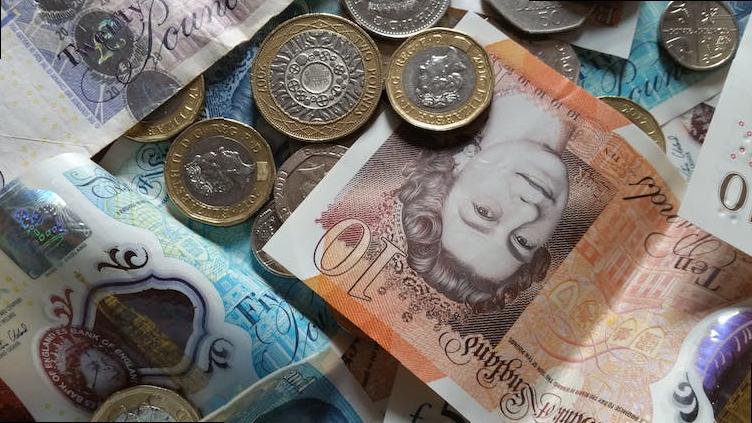
Overall, the cost of transportation in London can add up quickly, which is why it’s vital to budget for such expenses while planning to live in London. By knowing how much to allocate for transportation expenses and finding ways to save money, individuals can manage and live comfortably in one of the world’s most exciting and dynamic cities.
Transportation Costs
Transportation costs are an integral part of the cost of living in London. London is a large and diverse city, and the cost of getting around can vary greatly depending on where you live and work. The most common form of transportation are buses and the London Underground, which offers a comprehensive network of trains and underground lines. The cost of a single bus fare is £1.50, while a single trip on the underground can range from £2.40 to over £5 depending on the zones you are travelling through. The cost of a monthly travelcard can range from around £81.50 to £225, depending on the zones covered and the type of travelcard selected. Many Londoners also travel by car, but this can be expensive due to high fuel costs and the daily congestion charge that applies in central London. Overall, the cost of transportation in London can add up quickly, and it is important to factor this into your budget when considering the cost of living in the city.
Living In London
Living in London can be expensive, with the cost of living varying depending on individual lifestyles and habits. The estimated monthly living expenses in London, including accommodation, food, transportation, and other expenses, can range from £1,200 to £2,500 per month per person. The cost of accommodation in London is on the higher side, with the average rent for a one-bedroom apartment in the city center ranging from £1,000 to £2,000 per month. Utilities such as electricity, gas, and water can add up to an additional £150-200 per month. Eating out in London can vary depending on the location and restaurant, with an average meal costing around £15-20. In terms of transportation, the cost of a monthly pass for public transport in London is around £135, while taxis and ride-hailing services can be much more expensive. Other costs such as entertainment, clothing, and personal care can also add up. While living in London can be expensive, there are ways to save money such as living outside central London, cooking at home instead of eating out, and using public transportation instead of taxis.
Monthly Budgeting
Monthly budgeting is an important aspect of managing your finances while living in London. To cover basic expenses, such as rent, utilities, groceries, transportation, and entertainment, you should aim to have a budget of approximately £1,500-£2,000 per month.
Housing costs will likely be your biggest expense, and the amount you spend will depend on the area you choose to live in and whether you share a flat with roommates. Expect to pay around £900-£1200 per month for a small studio or one-bedroom apartment in central London, while sharing a larger apartment with roommates could bring costs down to about £600-£800 per month.
Food and groceries will typically cost around £300-£400 per month, and you can save money by shopping at affordable supermarkets such as Lidl or Aldi.
Transportation costs will vary depending on how often you use public transportation, but expect to spend around £130-£160 per month for a monthly travelcard.
Entertainment expenses such as going out to dinner, drinks, or seeing a movie will depend on personal preferences, but budgeting around £200 per month for leisure activities should be sufficient.
Overall, budgeting around £1,500-£2,000 per month is a good starting point to cover basic expenses while living in London.
Public Transport Expenses
In order to have a good idea of how much you need to live in London, it’s important to consider the expenses of public transport. Public transport is an essential part of getting around in London, and there are a few key factors to keep in mind.
Firstly, an adult travelcard for zones 1-2 costs £135.10 per month, or £1,578 for a year, and this provides unlimited travel on buses, the London Underground, Overground, and certain National Rail services within these zones. If you need to travel outside these zones, the cost of a travelcard will increase.
Secondly, if you’re a student, you may be eligible for a discounted travelcard, which can save you up to 30% on the cost of a regular adult card. The cost of a student travelcard for zones 1-2 is £81.50 per month, or £936 for a year.
Thirdly, it’s worth investigating whether you qualify for any other discounts or concessions, such as the 60+ Oyster card or the disabled person’s travel card.
Overall, the cost of public transport will depend on how frequently you use it and which zones you need to travel in. However, regardless of your circumstances, it’s essential to factor in the cost of public transport when calculating your expenses for living in London.
Tube Fares And Passes
The cost of tube fares and passes is an essential part of living in London. For a single adult journey in Zones 1-2, the fare with an Oyster card or contactless payment is £2.40. However, the daily cap on these types of cards is £7.20, meaning you won’t pay more than that for unlimited travel in one day.
For regular commuters, purchasing a Travelcard or a Bus & Tram Pass might be a more cost-effective option. A 7-day Travelcard for Zones 1-2 costs £35.10, while a monthly pass is £134.80. For frequent bus users, a Bus & Tram Pass costs £21.90 for 7 days or £84.10 monthly. Students and children can also get discounted fares.
For those living in outer London or commuting from further afield, the fares will be higher, depending on the location and zones. The cost of tube fares and passes is likely to vary according to individual circumstances and travel habits, but it is an important consideration when calculating the cost of living in London.
Bus Fares And Passes
Bus fares and passes are essential transportation options for those living in London. As of 2021, a single bus fare costs £1.55 for those who use an Oyster or contactless card, while cash fares cost £2.50. For those who regularly use public transportation, buying a Travelcard or a Bus & Tram Pass can provide significant savings.
A Weekly Bus & Tram Pass costs £21.90, a Monthly Bus & Tram Pass is priced at £84.10, and an Annual Bus & Tram Pass costs £848.00. A Travelcard, which provides unlimited travel across buses, trams, tubes, and trains, can cost anywhere from £13.50 to £88.80 per week depending on the number of zones they cover. For instance, a weekly Travelcard covering zones 1-2 costs £35.10, while one covering zones 1-6 costs £62.30.
The cost of living in London can be high, with the average monthly rent for a one-bedroom apartment ranging from £900-£1,500 depending on the area. A single person living in London would need to spend between £1,000 and £1,500 on basic living expenses per month, including rent, food, utilities, and transportation.
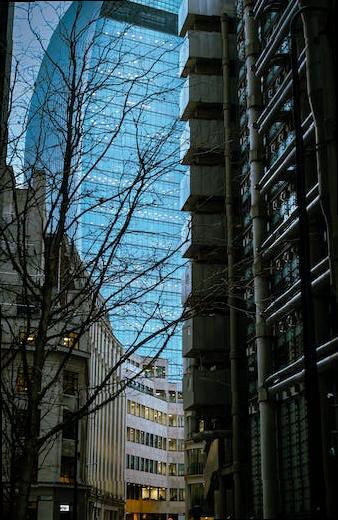
In summary, London bus fares and passes can provide cost-effective transportation options for those living in the city. For those on a tight budget, buying a Bus & Tram Pass or Travelcard can save a considerable amount of money on transportation costs, especially if they use public transportation regularly.
Cycling Expenses And Safety
Cycling expenses in London can vary depending on the type of cyclist you are. If you are a commuter, you will need to invest in a good quality bike as well as safety accessories such as a helmet, lights, and reflective clothing. These expenses can range from around £200-£500 for the bike, and £50-£100 for safety gear.
In terms of ongoing costs, there are some minor expenses such as bike maintenance and replacement parts such as tires, chains, and brake pads. Depending on how much you cycle, this can cost anywhere from £50-£200 per year.
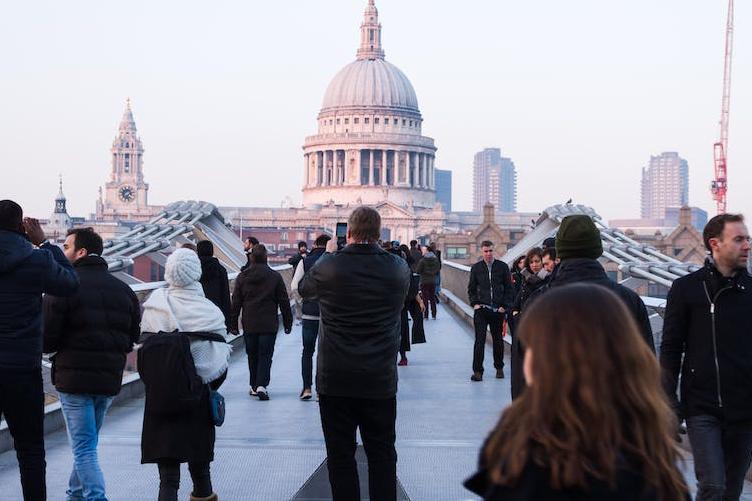
When it comes to cycling safety, it is important to invest in high-quality safety gear to prevent accidents. This includes not only a helmet and lights but also reflective clothing and accessories, such as a horn or bell to alert pedestrians and other cyclists. The price of safety gear can vary, but it is important to prioritize quality over price.
Overall, cycling can be a cost-effective and efficient mode of transportation in London, but it’s important to prioritize safety and invest in proper safety gear.
Car Ownership And Parking
Car ownership and parking in London can be quite expensive, and may not be a necessity for everyone. The cost of a car may include many factors such as buying or leasing the car, insurance, fuel, maintenance, road tax and parking.
Parking in London can be challenging and may take up a substantial portion of living expenses. London has some of the highest parking fees in the world, and costs can vary depending on the area. Residential parking permits are available for some areas but come at an additional cost.
Additionally, London has an extensive public transportation system making car ownership unnecessary for many people. The London Underground, buses, and trains provide access to all parts of the city and surrounding areas. Using public transportation is often cheaper than driving when taking into account the overall cost of car ownership.
In conclusion, car ownership and parking in London can be quite expensive, and may not always be necessary. The cost of owning a car may outweigh the benefits, especially when considering the city’s well-connected public transportation system.
Congestion Charge And Ulez
The Congestion Charge is a fee charged for driving a vehicle within Central London to reduce traffic congestion. The daily charge for driving within the Congestion Charge zone is £15, and it is in operation from 7 a.m. to 10 p.m. every day except Christmas Day. The Ultra-Low Emission Zone (ULEZ) is a charge that is applied in addition to the Congestion Charge for older, polluting vehicles. The ULEZ covers the same area as the Congestion Charge Zone and holders of vehicles that do not meet the ULEZ standards are required to pay a charge of £12.50 per day.
If you live in London, you need to consider the cost of the Congestion Charge and ULEZ if you regularly drive a vehicle within the zone. If you own an older, polluting car, you will need to pay an additional £12.50 per day. Living in London can be costly, with necessities such as accommodation and food adding up quickly. The average monthly rent for a one-bedroom apartment outside of Central London is around £1,200, and a weekly grocery bill for one person can cost around £50-£60.

Overall, living in London can be expensive, and residents need to consider the additional costs of the Congestion Charge and ULEZ on top of other daily expenses.
Budgeting For Unexpected Costs
Budgeting for unexpected costs is an important factor to consider when planning how much money you need to live in London. It is recommended to have some money set aside for emergencies, such as medical or household repairs, which can arise unexpectedly.
To live comfortably in London, the cost of living will depend on various factors such as accommodation, transportation, food, and entertainment. According to a study by Numbeo, the average monthly cost of living for a single person in London is around £1,050 to £1,800, depending on the location and lifestyle choices.
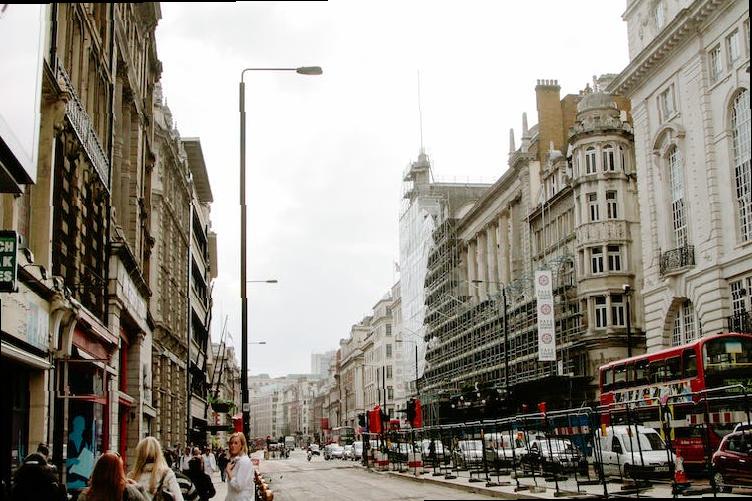
Housing is the largest expense in London, with renting a one-bedroom apartment in the city center costing an average of £1,600 per month. Transportation costs can range from £100 to £250 per month depending on the mode of transport used. Food expenses can also add up quickly, with an average meal costing around £15 in a mid-range restaurant.
In addition, it is important to account for unexpected costs such as medical emergencies, car repairs or replacing household items. It is recommended to have at least 3-6 months worth of living expenses saved up for emergencies.
Overall, budgeting for unexpected costs is crucial when planning how much money you need to live in London. With careful planning and budgeting, it is possible to live comfortably in this vibrant city.
In conclusion, the cost of living in London can vary greatly depending on a variety of factors, including location, accommodation type, transportation, food choices, and lifestyle. However, the general consensus is that London is one of the most expensive cities in the world, with high rent and living expenses. To comfortably live in London, it is recommended that individuals should have a minimum of £1,100 to £1,200 per month for basic expenses, such as rent, bills, food, and transportation. However, this amount can significantly increase depending on individual factors, such as personal preferences and lifestyle choices.
For those seeking accommodation, renting a one-bedroom apartment can cost anywhere from £800 to £1,500 per month, depending on the location, while a shared apartment can cost around £500 to £800 per month, excluding bills. Transportation costs can also add up, with a monthly travelcard costing approximately £135.
Food expenses can also vary depending on one’s food choices and lifestyle. Eating out at a restaurant can cost around £15 to £30 per person, while cooking at home can cost around £30 to £50 per week. Additionally, individuals may need to account for entertainment and personal expenses, such as gym memberships or leisure activities, which can add to their monthly expenses.
In summary, living in London can be an expensive endeavor, and individuals should have a financial plan in place before making the move. The recommended minimum amount for basic living expenses is around £1,100 to £1,200 per month, but this can significantly increase based on lifestyle choices and personal preferences. By carefully budgeting and living frugally, individuals can successfully manage the high cost of living in London.
- Travel Planning Guide

United Kingdom Travel Budget - Visit United Kingdom on a Budget or Travel in Style

- Is the United Kingdom Expensive?
- How much does a trip to the United Kingdom cost?
- UK On-Your-Own Itineraries
- Northern Ireland
- UK Hotel Prices
- UK Cities: Hotel Prices by City
- Best Family-Friendly Hotels in the United Kingdom
- Best Hotels for One Week in the United Kingdom
- Best Hotels for First Time Visitors in the United Kingdom
- Best Romantic Hotels for Couples in the United Kingdom
- Best Beach Hotels in the United Kingdom
- Best Pet-Friendly Hotels in the United Kingdom
- Best Hotels for One Night in the United Kingdom
- Best Hotels for Skiing in the United Kingdom
- Best Hotels for Scuba Diving in the United Kingdom
- Best Adults Only Hotels in the United Kingdom
- Best Party Hotels in the United Kingdom
- Best Luxury Hotels in the United Kingdom
- Best Cheap Hotels in the United Kingdom
- Best Hotels for a Weekend Getaway in the United Kingdom
- Best Business Hotels in the United Kingdom
- Hostel Prices & Reviews
- UK Activities
- UK Tour Prices
- The Best Family-Friendly Tours to UK
- The Best Hiking & Trekking Tours in UK
- The Best Historical Tours in UK
- The Best One Week (7-Day) Tours in UK
- The Best 3-Day Tours in UK
- The Best Bicycle Tours in UK
- Tours for Outdoor and Nature Lovers in UK
- The Best Christmas & New Years Tours in UK
- The Best Coach Bus Tours in UK
- The Best Adventure Tours to UK
- The Best Eco Tours in UK
- The Best Sightseeing Tours in UK
- The Best Cultural Tours in UK
- The Best Romantic Tours for Couples in UK
- The Best Tours Under $1000 in UK
- The Best Luxury Tours to UK
- The Best Budget Tours to UK
- The Best Tours for Seniors to UK
- Lake District National Park
- How much does it cost to travel to the United Kingdom? (Average Daily Cost)
- The United Kingdom trip costs: one week, two weeks, one month
How much do package tours cost in the United Kingdom?
Is the united kingdom expensive to visit.
- How much do I need for a trip to the United Kingdom?
- Accommodation, Food, Entertainment, and Transportation Costs
- Travel Guide
How much does it cost to travel to the United Kingdom?
You should plan to spend around $191 (£153) per day on your vacation in the United Kingdom. This is the average daily price based on the expenses of other visitors.
Past travelers have spent, on average for one day:
- $46 (£37) on meals
- $36 (£29) on local transportation
- $190 (£152) on hotels
A one week trip to the United Kingdom for two people costs, on average, $2,668 (£2,142) . This includes accommodation, food, local transportation, and sightseeing.
All of these average travel prices have been collected from other travelers to help you plan your own travel budget.
- Travel Style: All Budget (Cheap) Mid-Range Luxury (High-End)
- Average Daily Cost Per person, per day $ 191 £ 153
- One Week Per person $ 1,334 £ 1,071
- 2 Weeks Per person $ 2,668 £ 2,142
- One Month Per person $ 5,717 £ 4,590
- One Week For a couple $ 2,668 £ 2,142
- 2 Weeks For a couple $ 5,336 £ 4,284
- One Month For a couple $ 11,434 £ 9,179
Help other travelers! Answer some quick questions about your past travels. Click here: let's do it!
How much does a one week, two week, or one month trip to the United Kingdom cost?
A one week trip to the United Kingdom usually costs around $1,334 (£1,071) for one person and $2,668 (£2,142) for two people. This includes accommodation, food, local transportation, and sightseeing.
A two week trip to the United Kingdom on average costs around $2,668 (£2,142) for one person and $5,336 (£4,284) for two people. This cost includes accommodation, food, local transportation, and sightseeing.
Please note, prices can vary based on your travel style, speed, and other variables. If you're traveling as a family of three or four people, the price per person often goes down because kid's tickets are cheaper and hotel rooms can be shared. If you travel slower over a longer period of time then your daily budget will also go down. Two people traveling together for one month in the United Kingdom will often have a lower daily budget per person than one person traveling alone for one week.
A one month trip to the United Kingdom on average costs around $5,717 (£4,590) for one person and $11,434 (£9,179) for two people. The more places you visit, the higher the daily price will become due to increased transportation costs.
Organized tours are usually more expensive than independent travel, but offer convenience and peace of mind that your trip has been planned by a travel expert.
The average price for an organized tour package in the United Kingdom is $282 per day. While every tour varies by total price, length, number of destinations, and quality, this is the daily average price based on our analysis of available guided tours.
- 4 Day Cornwall, Devon & Stonehenge Small-Group Tour from Bristol 4 Days - 16 Destinations $ 792
- Hot Tam!: Scotland By Design 9 Days - 12 Destinations $ 2,699
Independent Travel
Traveling Independently has many benefits including affordabilty, freedom, flexibility, and the opportunity to control your own experiences.
All of the travel costs below are based on the experiences of other independent travelers.
The United Kingdom is a moderately priced destination to visit. It's about average with most other countries for travel costs. The prices for food, accommodation, and transportation are all fairly reasonable.
Within Europe, which is known to be an expensive region, the United Kingdom is moderately priced compared to the other countries. The overall cost of travel here is comparable to the Netherlands or Denmark.
For more details, see Is the United Kingdom Expensive?
How much money do I need for a trip to the United Kingdom?
The average United Kingdom trip cost is broken down by category here for independent travelers. All of these United Kingdom travel prices are calculated from the budgets of real travelers.
Accommodation Budget in the United Kingdom
Average daily costs.
Calculated from travelers like you
The average price paid for one person for accommodation in the United Kingdom is $95 (£76). For two people sharing a typical double-occupancy hotel room, the average price paid for a hotel room in the United Kingdom is $190 (£152). This cost is from the reported spending of actual travelers.
- Accommodation 1 Hotel or hostel for one person $ 95 £ 76
- Accommodation 1 Typical double-occupancy room $ 190 £ 152
Hotel Prices in the United Kingdom
Looking for a hotel in the United Kingdom? Prices vary by location, date, season, and the level of luxury. See below for options.
Find the best hotel for your travel style.
Actual Hotel Prices The average hotel room price in the United Kingdom based on data provided by Kayak for actual hotel rooms is $113. (Prices in U.S. Dollars, before taxes & fees.)
Kayak helps you find the best prices for hotels, flights, and rental cars for destinations around the world.
Recommended Properties
- Abergavenny Hotel Budget Hotel - Kayak $ 173
- East Horton Farmhouse Luxury Hotel - Kayak $ 114
Local Transportation Budget in the United Kingdom
The cost of a taxi ride in the United Kingdom is significantly more than public transportation. On average, past travelers have spent $36 (£29) per person, per day, on local transportation in the United Kingdom.
- Local Transportation 1 Taxis, local buses, subway, etc. $ 36 £ 29
Recommended Services
- One Way Taxi Transfer from London to Stansted Airport Viator $ 190
- One-Way Taxi Transfer from Stansted Airport to London Viator $ 189
What did other people spend on Local Transportation?
Typical prices for Local Transportation in the United Kingdom are listed below. These actual costs are from real travelers and can give you an idea of the Local Transportation prices in the United Kingdom, but your costs will vary based on your travel style and the place where the purchase was made.
- Oyster Card £ 27
- Train to Gatwick Airport (2) £ 22
- Toll Way - Mersey tunnel £ 1.70
- Parking £ 1.70
- Parking in Manchester £ 3.00
- City bike hire Liverpool £ 6.00
- Parking £ 2.00
- Ferry to Isle of Wight £ 16
Food Budget in the United Kingdom
While meal prices in the United Kingdom can vary, the average cost of food in the United Kingdom is $46 (£37) per day. Based on the spending habits of previous travelers, when dining out an average meal in the United Kingdom should cost around $19 (£15) per person. Breakfast prices are usually a little cheaper than lunch or dinner. The price of food in sit-down restaurants in the United Kingdom is often higher than fast food prices or street food prices.
- Food 2 Meals for one day $ 46 £ 37
Recommended
- Traditional English Walking Food Tour With London Food Tours Viator $ 95
- Durham Food Tour Viator $ 94
What did other people spend on Food?
Typical prices for Food in the United Kingdom are listed below. These actual costs are from real travelers and can give you an idea of the Food prices in the United Kingdom, but your costs will vary based on your travel style and the place where the purchase was made.
- Lunch for 2 £ 23
- Lunch for 2 £ 46
- Nice lunch at Fleece £ 61
- Coffee (2) £ 4.80
- Turkish Delight £ 1.40
- 2 Coffees and Scones £ 5.80
- Soup at the Pub £ 5.90
- Lunch for 2 £ 17
Entertainment Budget in the United Kingdom
Entertainment and activities in the United Kingdom typically cost an average of $34 (£27) per person, per day based on the spending of previous travelers. This includes fees paid for admission tickets to museums and attractions, day tours, and other sightseeing expenses.
- Entertainment 1 Entrance tickets, shows, etc. $ 34 £ 27
Recommended Activities
- Agatha Christie walking tour - the story of her extraordinary life Viator $ 25
- Cotswold Walks & Villages Tour from Stratford-upon-Avon or Moreton-in-Marsh Viator $ 107
What did other people spend on Entertainment?
Typical prices for Entertainment in the United Kingdom are listed below. These actual costs are from real travelers and can give you an idea of the Entertainment prices in the United Kingdom, but your costs will vary based on your travel style and the place where the purchase was made.
- Lunch £ 12
- Comedy Show £ 8.00
- London Pass £ 47
- Warwick Castle (2) £ 59
- Thermal Bath Spa £ 35
- Luss Highland Games Entrance Fee (for 2) £ 12
- Two Bike Rental £ 34
Tips and Handouts Budget in the United Kingdom
The average cost for Tips and Handouts in the United Kingdom is $31 (£25) per day. The usual amount for a tip in the United Kingdom is 10% - 20% .
- Tips and Handouts 1 For guides or service providers $ 31 £ 25
Scams, Robberies, and Mishaps Budget in the United Kingdom
Unfortunately, bad things can happen on a trip. Well, you've just got to deal with it! The average price for a scam, robbery, or mishap in the United Kingdom is $92 (£74), as reported by travelers.
- Scams, Robberies, and Mishaps 1 $ 92 £ 74
Alcohol Budget in the United Kingdom
The average person spends about $16 (£13) on alcoholic beverages in the United Kingdom per day. The more you spend on alcohol, the more fun you might be having despite your higher budget.
- Alcohol 2 Drinks for one day $ 16 £ 13
- Shakespeare Distillery Tour - 11am Ticket Viator $ 25
- Tayport Distillery Tour & Tastings Viator $ 19
What did other people spend on Alcohol?
Typical prices for Alcohol in the United Kingdom are listed below. These actual costs are from real travelers and can give you an idea of the Alcohol prices in the United Kingdom, but your costs will vary based on your travel style and the place where the purchase was made.
- Half Pint at Tollbooth Tavern £ 1.65
- Ciders at Kilted Skirlie £ 3.50
- Bottle of Wine £ 12
- Drinks at the Walnut Pub (for 2) £ 10
- Pitcher of Pimms £ 15
- Drinks at the Pub (for 2) £ 7.55
- Beer & Wine £ 14
- Beers £ 8.00
Water Budget in the United Kingdom
On average, people spend $4.99 (£4.00) on bottled water in the United Kingdom per day. The public water in the United Kingdom is considered safe to drink.
- Water 2 Bottled water for one day $ 4.99 £ 4.00
Related Articles
The united kingdom on a budget.

At A Glance
- London is notoriously expensive. It's easily the cheapest city to fly into, but once you arrive you'll find your money quickly disappears. If you're hoping to keep costs down, spend more time in the other areas around the United Kingdom and less time in London. In the more rural communities you'll find that your expenses are far less.
- The countries that make up the United Kingdom each have their own set of bank holidays. Look at a calender before you schedule your trip to make sure that your vacation does not overlap any of these bank holidays. If it does, you will find that prices are higher and attractions are more crowded.
- There are many discount airlines that fly into and out of London and the United Kingdom. If you book tickets through one of these airlines, make sure that you understand all of the restrictions as well as what's included in the price. Some flights fly into inconvenient airports as well, so confirm that there are transportation connections available to where you need to go.
- If you're traveling by train, there are usually discounts available for children or groups. Also, there are regional railcards available if you plan to take several different trips within the area. Research all of the restrictions on these cards prior to purchasing them. If you do decide to buy single tickets, it is best to buy them in advance when the prices are often lower. Great Britain is an area where you will benefit from having a set schedule and itinerary in advance of your trip.
- There are several different bus companies available throughout the country. The buses are usually of high quality and they generally run on schedule. The more popular bus companies include National Express, Megabus, CityLink, and Dot2Dot. Some companies are focused on specific regions, while other serve the entire country. Some companies are also notoriously cheaper than others.
Top Tourist Attractions
Popular foods, more related articles.
We've been gathering travel costs from tens of thousands of actual travelers since 2010, and we use the data to calculate average daily travel costs for destinations around the world. We also systematically analyze the prices of hotels, hostels, and tours from travel providers such as Kayak, HostelWorld, TourRadar, Viator, and others. This combination of expenses from actual travelers, combined with pricing data from major travel companies, gives us a uniqe insight into the overall cost of travel for thousands of cities in countries around the world. You can see more here: How it Works .
Subscribe to our Newsletter
By signing up for our email newsletter, you will receive occasional updates from us with sales and discounts from major travel companies , plus tips and advice from experienced budget travelers!

Search for Travel Costs
Some of the links on this website are sponsored or affiliate links which help to financially support this site. By clicking the link and making a purchase, we may receive a small commission, but this does not affect the price of your purchase.
Travel Cost Data
You are welcome to reference or display our travel costs on your website as long as you provide a link back to this page .
A Simple Link
For a basic link, you can copy and paste the HTML link code or this page's address.
Travel Cost Widget
To display all of the data, copy and paste the code below to display our travel cost widget . Make sure that you keep the link back to our website intact.
- Privacy / Terms of Use
- Activities, Day Trips, Things To Do, and Excursions
Our 2024 Casual Tourist Guides are here ✨
Country/region
- GBP £ | Afghanistan
- GBP £ | Åland Islands
- GBP £ | Albania
- GBP £ | Algeria
- GBP £ | Andorra
- GBP £ | Angola
- GBP £ | Anguilla
- GBP £ | Antigua & Barbuda
- GBP £ | Argentina
- GBP £ | Armenia
- GBP £ | Aruba
- GBP £ | Ascension Island
- GBP £ | Australia
- GBP £ | Austria
- GBP £ | Azerbaijan
- GBP £ | Bahamas
- GBP £ | Bahrain
- GBP £ | Bangladesh
- GBP £ | Barbados
- GBP £ | Belarus
- EUR € | Belgium
- GBP £ | Belize
- GBP £ | Benin
- GBP £ | Bermuda
- GBP £ | Bhutan
- GBP £ | Bolivia
- GBP £ | Bosnia & Herzegovina
- GBP £ | Botswana
- GBP £ | Brazil
- GBP £ | British Indian Ocean Territory
- GBP £ | British Virgin Islands
- GBP £ | Brunei
- GBP £ | Bulgaria
- GBP £ | Burkina Faso
- GBP £ | Burundi
- GBP £ | Cambodia
- GBP £ | Cameroon
- CAD $ | Canada
- GBP £ | Cape Verde
- GBP £ | Caribbean Netherlands
- GBP £ | Cayman Islands
- GBP £ | Central African Republic
- GBP £ | Chad
- GBP £ | Chile
- GBP £ | China
- GBP £ | Christmas Island
- GBP £ | Cocos (Keeling) Islands
- GBP £ | Colombia
- GBP £ | Comoros
- GBP £ | Congo - Brazzaville
- GBP £ | Congo - Kinshasa
- GBP £ | Cook Islands
- GBP £ | Costa Rica
- GBP £ | Côte d’Ivoire
- GBP £ | Croatia
- GBP £ | Curaçao
- GBP £ | Cyprus
- GBP £ | Czechia
- GBP £ | Denmark
- GBP £ | Djibouti
- GBP £ | Dominica
- GBP £ | Dominican Republic
- GBP £ | Ecuador
- GBP £ | Egypt
- GBP £ | El Salvador
- GBP £ | Equatorial Guinea
- GBP £ | Eritrea
- GBP £ | Estonia
- GBP £ | Eswatini
- GBP £ | Ethiopia
- GBP £ | Falkland Islands
- GBP £ | Faroe Islands
- GBP £ | Fiji
- GBP £ | Finland
- EUR € | France
- GBP £ | French Guiana
- GBP £ | French Polynesia
- GBP £ | French Southern Territories
- GBP £ | Gabon
- GBP £ | Gambia
- GBP £ | Georgia
- EUR € | Germany
- GBP £ | Ghana
- GBP £ | Gibraltar
- EUR € | Greece
- GBP £ | Greenland
- GBP £ | Grenada
- GBP £ | Guadeloupe
- GBP £ | Guatemala
- GBP £ | Guernsey
- GBP £ | Guinea
- GBP £ | Guinea-Bissau
- GBP £ | Guyana
- GBP £ | Haiti
- GBP £ | Honduras
- GBP £ | Hong Kong SAR
- GBP £ | Hungary
- GBP £ | Iceland
- GBP £ | India
- GBP £ | Indonesia
- GBP £ | Iraq
- EUR € | Ireland
- GBP £ | Isle of Man
- GBP £ | Israel
- EUR € | Italy
- GBP £ | Jamaica
- GBP £ | Japan
- GBP £ | Jersey
- GBP £ | Jordan
- GBP £ | Kazakhstan
- GBP £ | Kenya
- GBP £ | Kiribati
- GBP £ | Kosovo
- GBP £ | Kuwait
- GBP £ | Kyrgyzstan
- GBP £ | Laos
- GBP £ | Latvia
- GBP £ | Lebanon
- GBP £ | Lesotho
- GBP £ | Liberia
- GBP £ | Libya
- GBP £ | Liechtenstein
- GBP £ | Lithuania
- GBP £ | Luxembourg
- GBP £ | Macao SAR
- GBP £ | Madagascar
- GBP £ | Malawi
- GBP £ | Malaysia
- GBP £ | Maldives
- GBP £ | Mali
- GBP £ | Malta
- GBP £ | Martinique
- GBP £ | Mauritania
- GBP £ | Mauritius
- GBP £ | Mayotte
- GBP £ | Mexico
- GBP £ | Moldova
- GBP £ | Monaco
- GBP £ | Mongolia
- GBP £ | Montenegro
- GBP £ | Montserrat
- GBP £ | Morocco
- GBP £ | Mozambique
- GBP £ | Myanmar (Burma)
- GBP £ | Namibia
- GBP £ | Nauru
- GBP £ | Nepal
- EUR € | Netherlands
- GBP £ | New Caledonia
- GBP £ | New Zealand
- GBP £ | Nicaragua
- GBP £ | Niger
- GBP £ | Nigeria
- GBP £ | Niue
- GBP £ | Norfolk Island
- GBP £ | North Macedonia
- GBP £ | Norway
- GBP £ | Oman
- GBP £ | Pakistan
- GBP £ | Palestinian Territories
- GBP £ | Panama
- GBP £ | Papua New Guinea
- GBP £ | Paraguay
- GBP £ | Peru
- GBP £ | Philippines
- GBP £ | Pitcairn Islands
- GBP £ | Poland
- EUR € | Portugal
- GBP £ | Qatar
- GBP £ | Réunion
- EUR € | Romania
- GBP £ | Russia
- GBP £ | Rwanda
- GBP £ | Samoa
- EUR € | San Marino
- GBP £ | São Tomé & Príncipe
- GBP £ | Saudi Arabia
- GBP £ | Senegal
- GBP £ | Serbia
- GBP £ | Seychelles
- GBP £ | Sierra Leone
- GBP £ | Singapore
- GBP £ | Sint Maarten
- GBP £ | Slovakia
- GBP £ | Slovenia
- GBP £ | Solomon Islands
- GBP £ | Somalia
- GBP £ | South Africa
- GBP £ | South Georgia & South Sandwich Islands
- GBP £ | South Korea
- GBP £ | South Sudan
- EUR € | Spain
- GBP £ | Sri Lanka
- GBP £ | St. Barthélemy
- GBP £ | St. Helena
- GBP £ | St. Kitts & Nevis
- GBP £ | St. Lucia
- GBP £ | St. Martin
- GBP £ | St. Pierre & Miquelon
- GBP £ | St. Vincent & Grenadines
- GBP £ | Sudan
- GBP £ | Suriname
- GBP £ | Svalbard & Jan Mayen
- GBP £ | Sweden
- GBP £ | Switzerland
- GBP £ | Taiwan
- GBP £ | Tajikistan
- GBP £ | Tanzania
- GBP £ | Thailand
- GBP £ | Timor-Leste
- GBP £ | Togo
- GBP £ | Tokelau
- GBP £ | Tonga
- GBP £ | Trinidad & Tobago
- GBP £ | Tristan da Cunha
- GBP £ | Tunisia
- GBP £ | Türkiye
- GBP £ | Turkmenistan
- GBP £ | Turks & Caicos Islands
- GBP £ | Tuvalu
- GBP £ | U.S. Outlying Islands
- GBP £ | Uganda
- GBP £ | Ukraine
- GBP £ | United Arab Emirates
- GBP £ | United Kingdom
- USD $ | United States
- GBP £ | Uruguay
- GBP £ | Uzbekistan
- GBP £ | Vanuatu
- EUR € | Vatican City
- GBP £ | Venezuela
- GBP £ | Vietnam
- GBP £ | Wallis & Futuna
- GBP £ | Western Sahara
- GBP £ | Yemen
- GBP £ | Zambia
- GBP £ | Zimbabwe

Item added to your cart
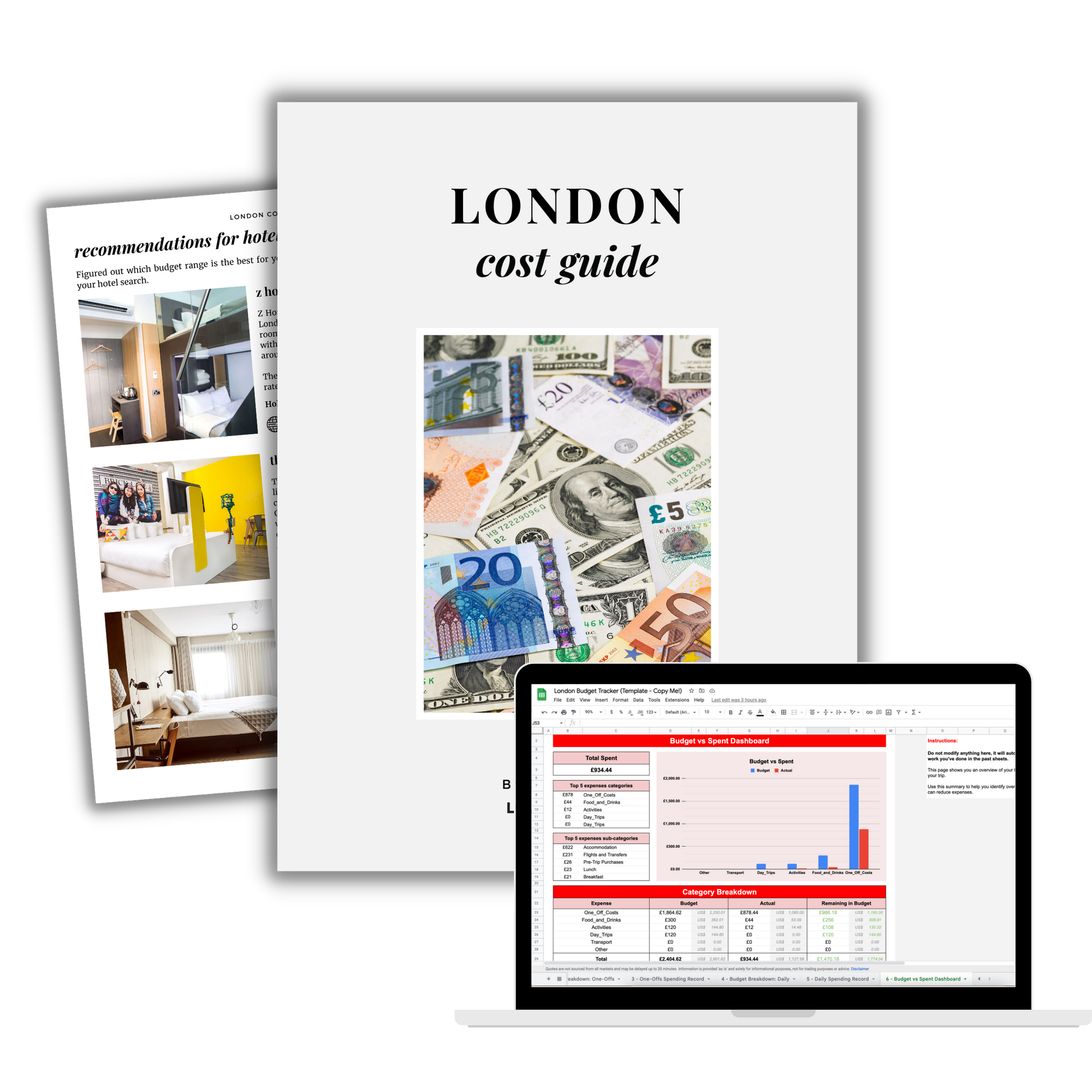
London Spending Guide
Couldn't load pickup availability
Struggling to figure out the budget for your London trip?
The London Spending Guide is a tool that does just that. It comes with:
1. London Cost Guide - a PDF filled with advice about getting and spending money in London, plus guides for how much you can expect to pay for certain parts of your trip, and recommendations for hotels, food, drink and activities for every budget level.
2. London Budget Tracker - an easy-to-use but incredibly comprehensive Google Sheets template. Calculate how much money you need to save each month to pay for your trip, figure out the total amount you can spend, play with your numbers to see where you want to splurge and where you want to save, and keep track of your daily spending while in London so you can stay on budget. It's available for 30+ different currencies (see which ones in the FAQ section below.)
Keep scrolling for more information, FAQs, a sneak peek inside, and more.
Are you struggling to create a budget for your London trip?
London is SUCH an expensive city, so it’s really easy to crush your budget without even noticing, especially when you’re also dealing with trying to do currency conversions in your head on the fly.
It’s also really hard to get a good idea of how much every part of your trip is going to cost, thinking about food, drinks, and little things like a late-night Uber ride after emerging from the club at 3am…
So to help you figure out your London trip budget and stick to it, there's the London Spending Guide.
BTW, if you love a spreadsheet, you’ll geek out over this 😉
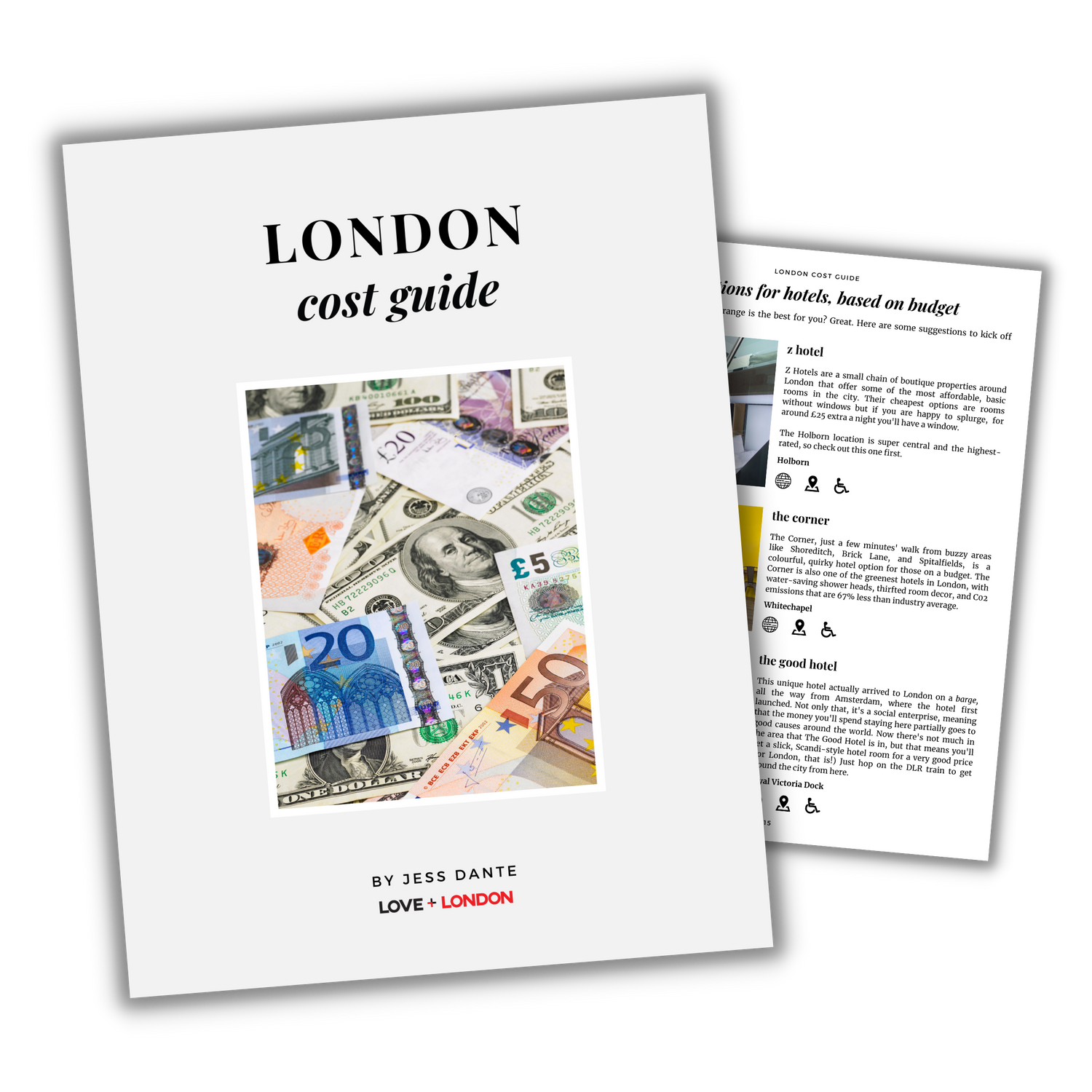
What do you get with the London Spending Guide?
1. The London Cost Guide, a PDF with:
- Money and spending tips
- Price ranges to expect for hotels, transport, food and more
- Specific recommendations from Jess for "budget", "mid-range" and "luxury" restaurants, hotels, bars and activities
... and more
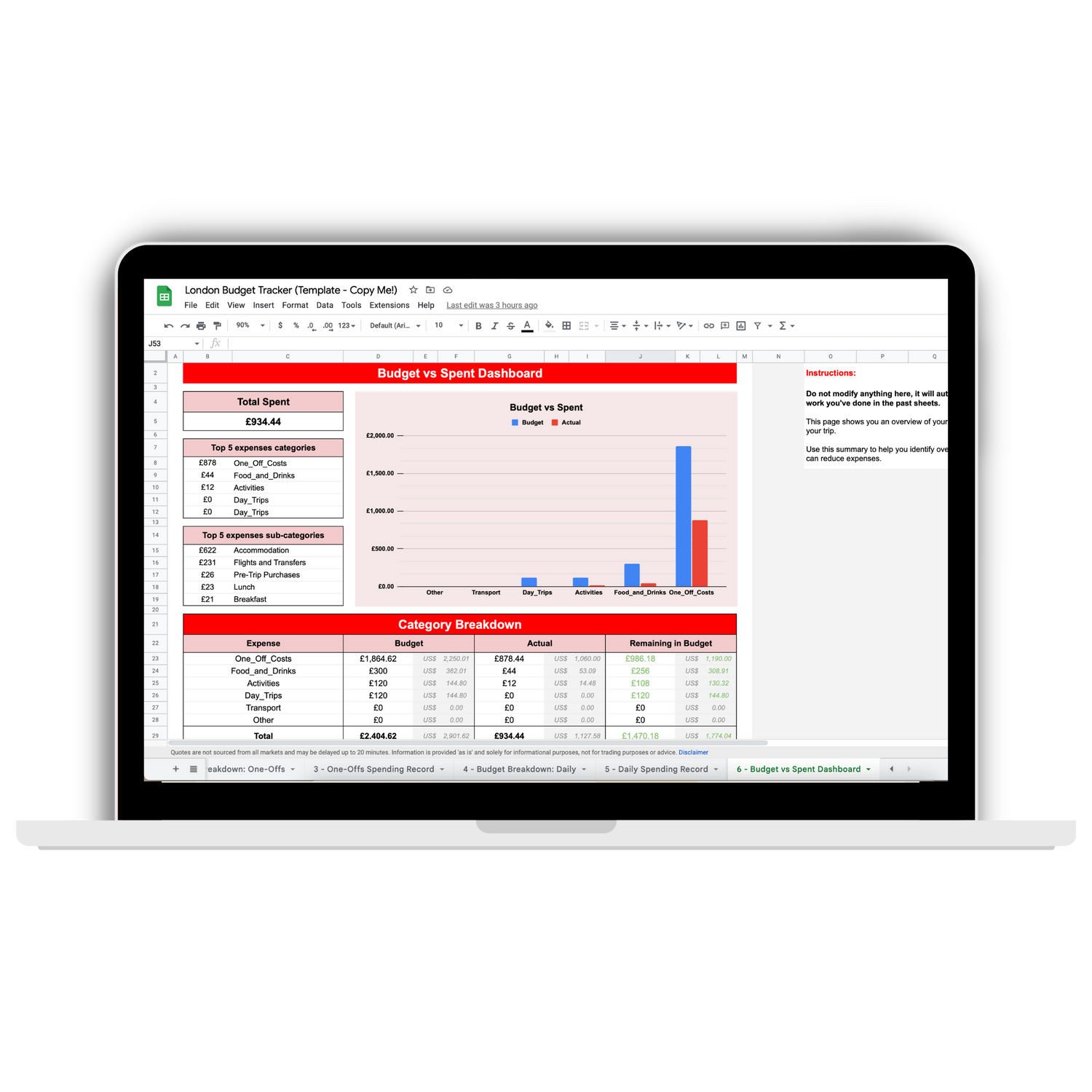
2 - London Budget Tracker
A comprehensive, but easy-to-use Google Sheets template to help you:
- Figure out how much you need to save from each pay period to reach your trip savings goal (in your currency, 30+ are available!)
- Calculate your total trip budget for the type of travel you want to do (budget, luxury, etc.)
- Play around with your budgets for each category so you know where you want to spend more and where you want to save money
- Keep track of your daily spending so you know how much you have left in your budget and when you've overspent
A breakdown of the London Spending Guide...
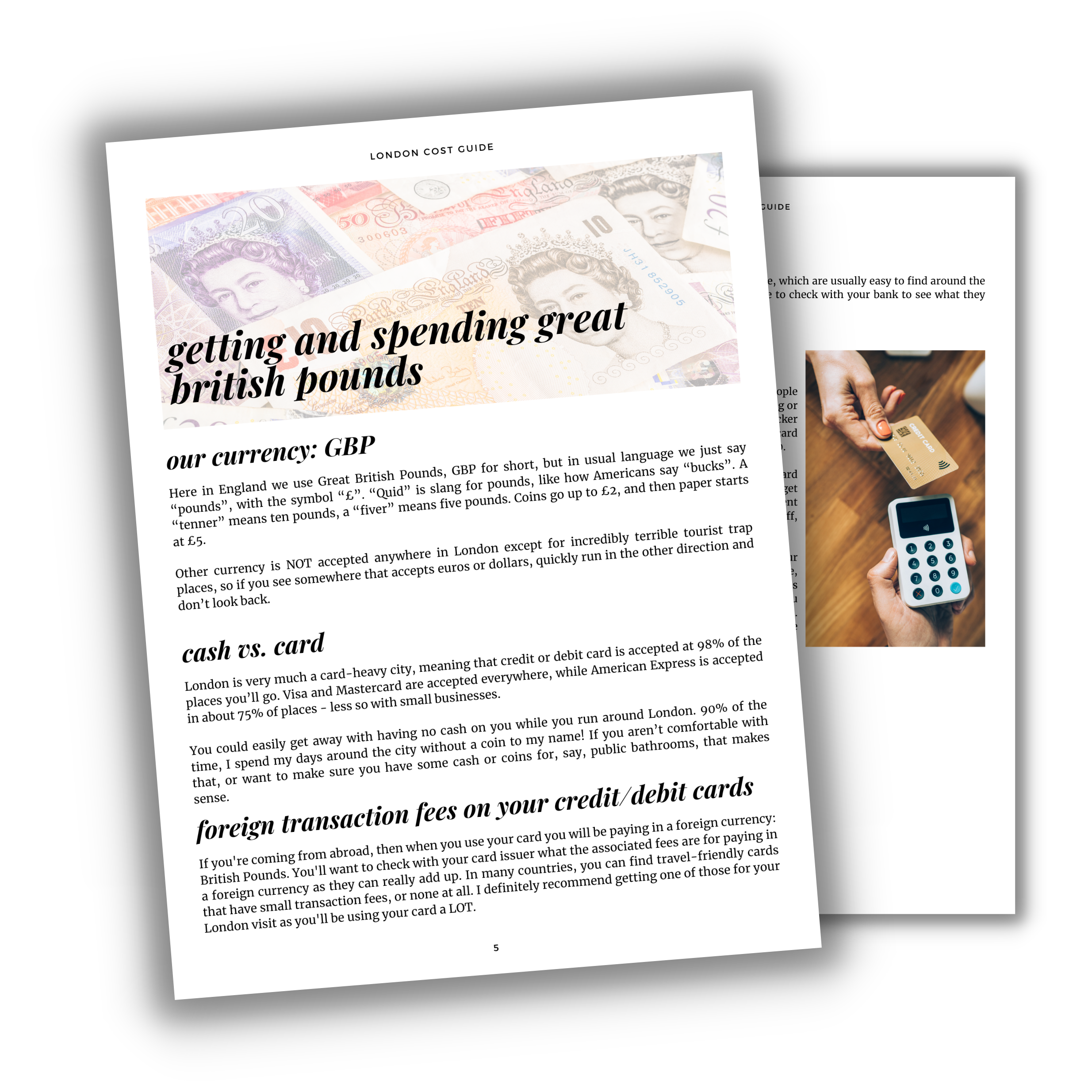
Getting and spending Great British Pounds
Information about our currency, cash vs. card, foreign transaction fees on your credit/debit cards, how to get cashed contactless payment methods.
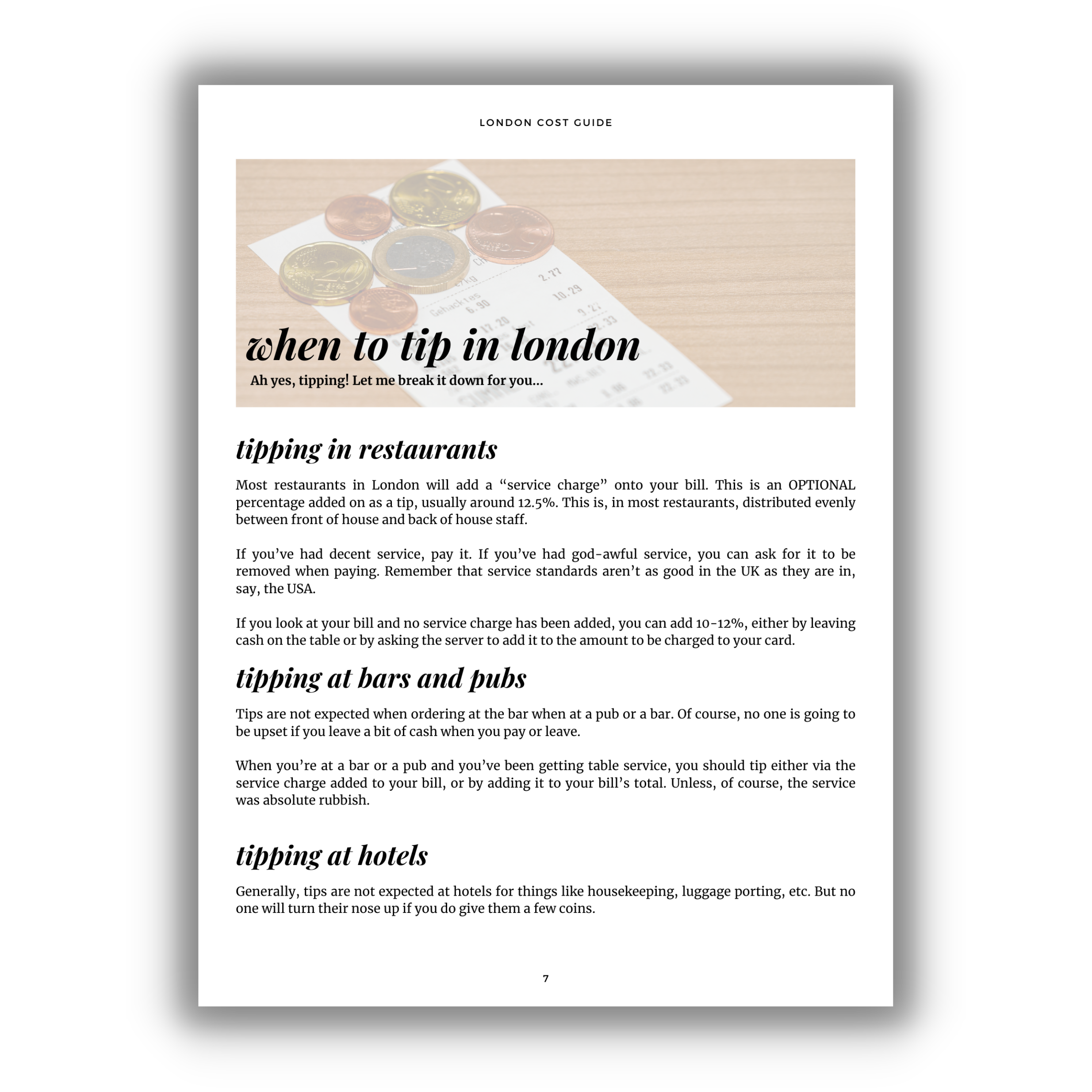
London's Tipping Culture
We break down tipping for you... with information on when to tip in restaurants, bars and pubs, hotels, tour guides, taxis, salons, spas...
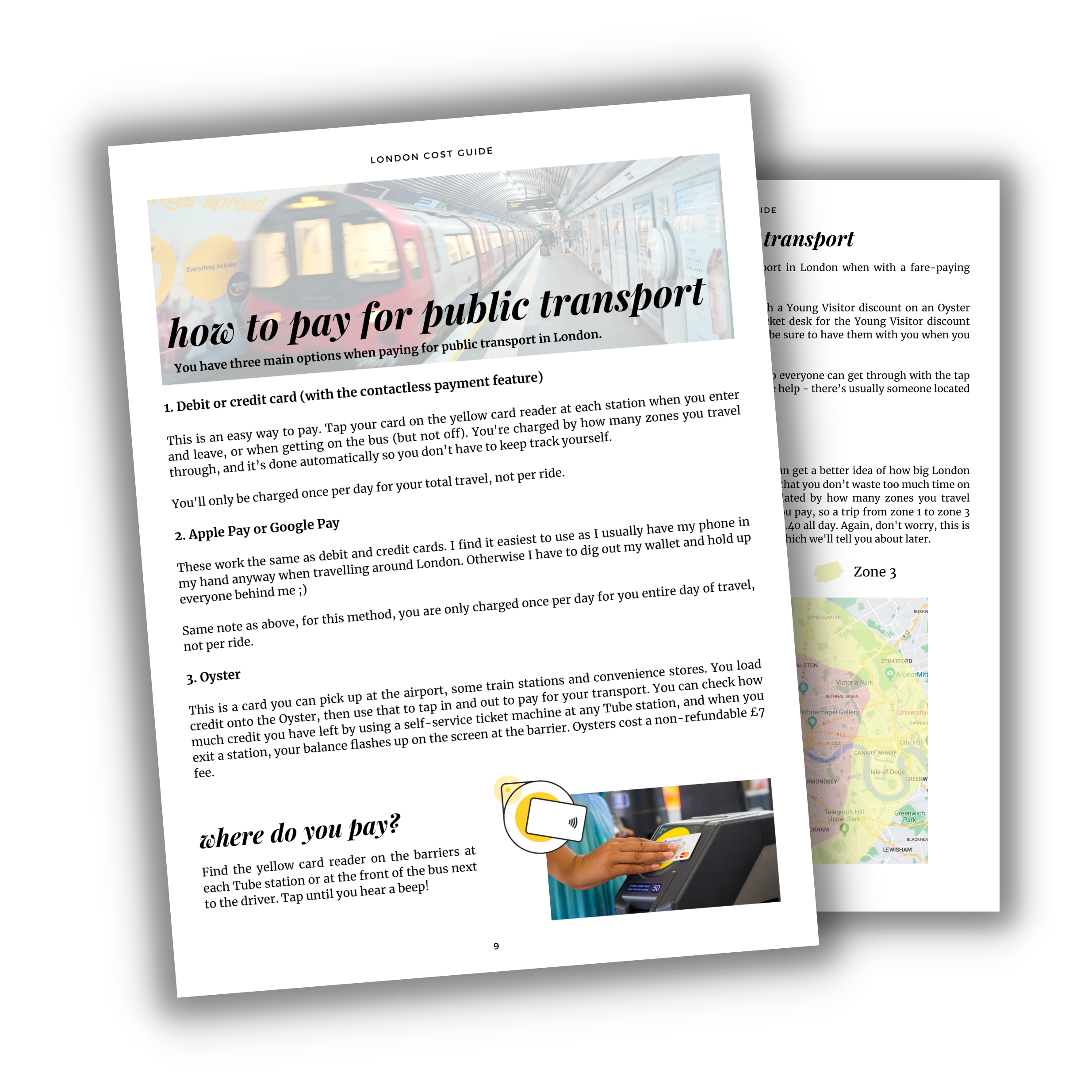
Info about London's Public Transport
How to pay for public transport, the cost of it and how to estimate your spending, kids discount, other travelling methods and a map of London zones (1-3).

Accommodation
While London is a super expensive city, there are plenty of accommodation options no matter what your budget is.
Includes recommendations of hotels (budget, mid-range and luxurious options), hostels and apart-hotels.
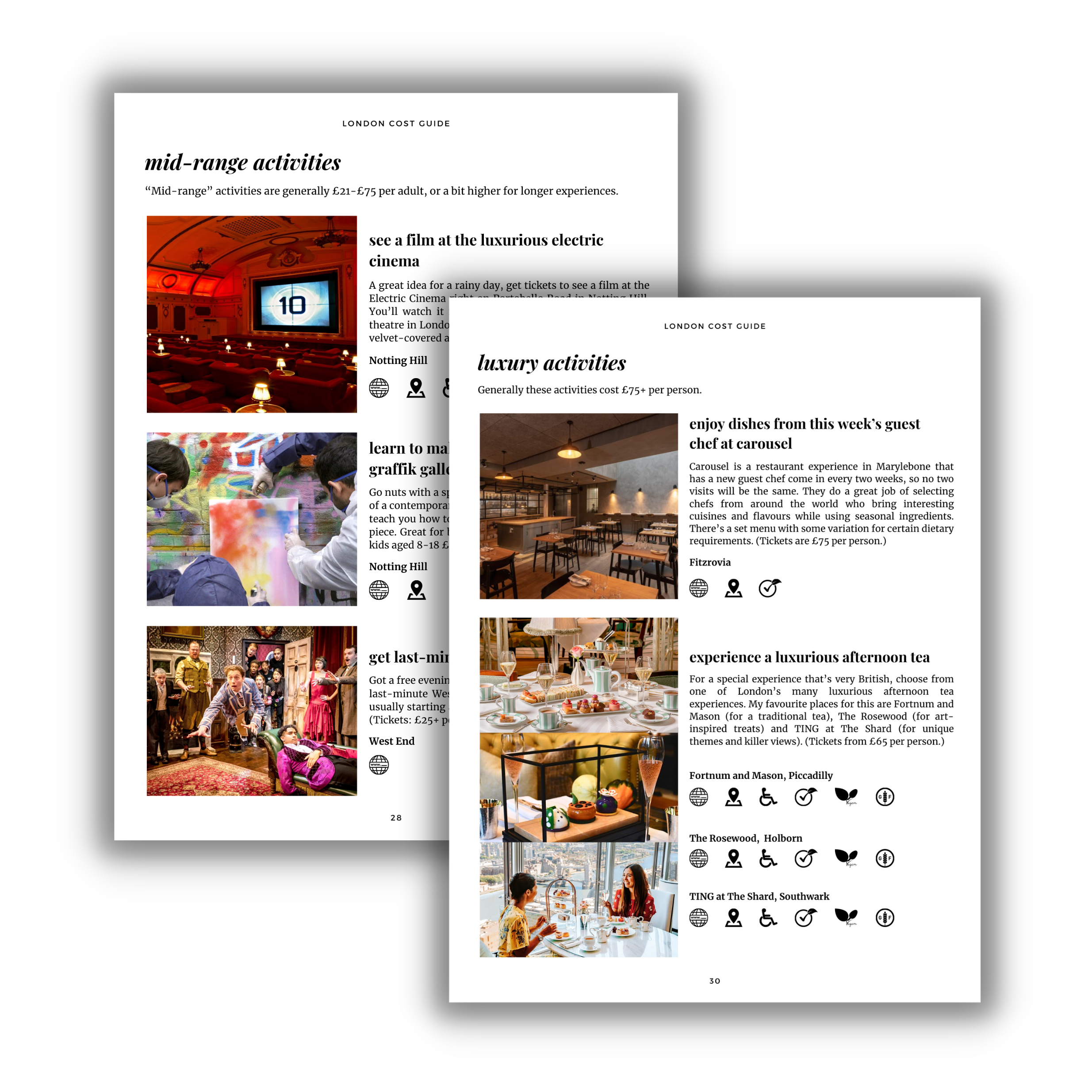
Activities and Experiences
There are SO many fun things to do around London, from cheese classes to free museums to helicopter rides.
Includes recommendations of free, budget, mid-range and luxurious activities/experiences.

Food and Drinks
No matter what your budget, you can eat well and have a few drinks without breaking the bank.
Includes recommendations for budget, mid-range and luxury travellers.
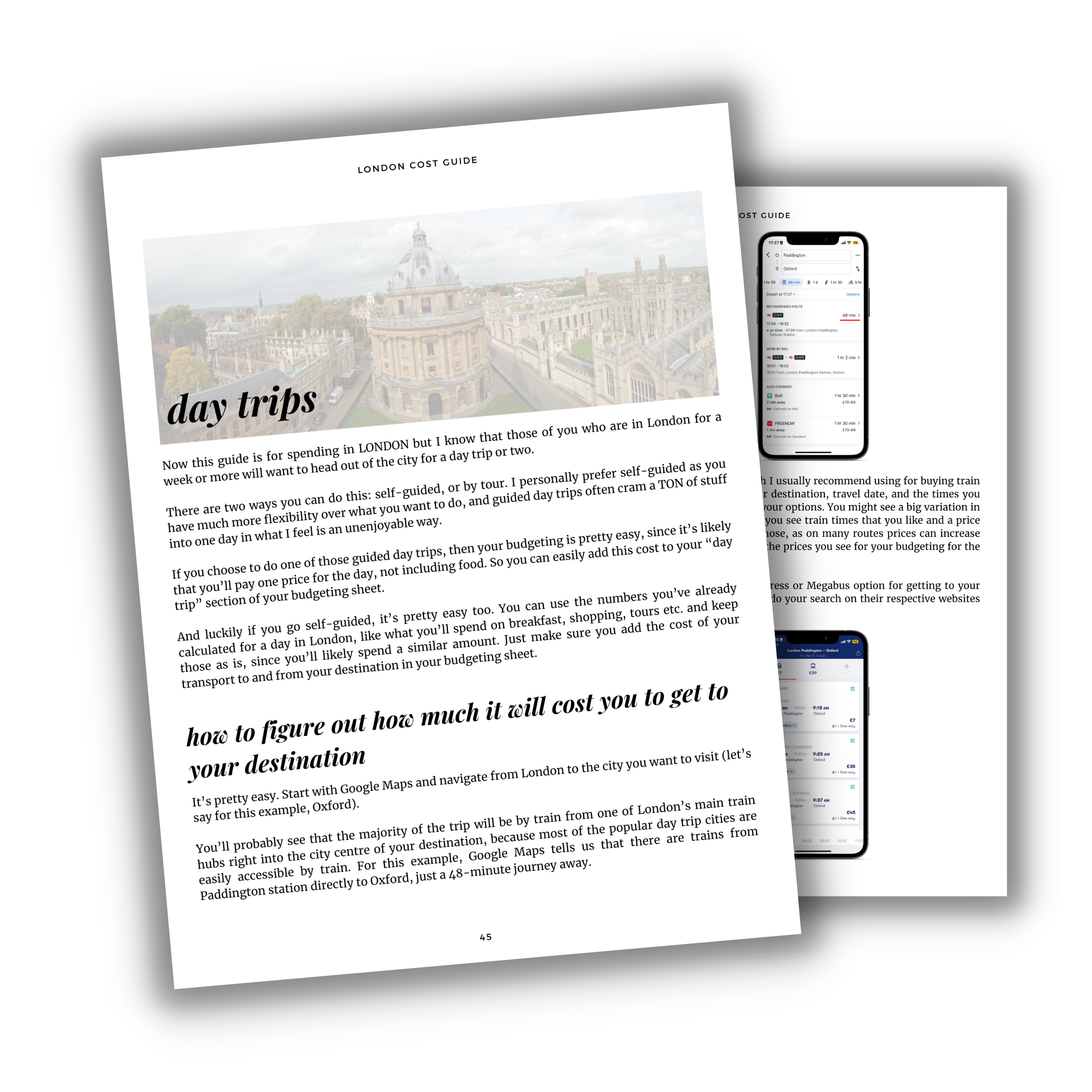
Day trips from London
How to figure out how much it will cost you to get to your destination, train tickets discounts and some recommendations.
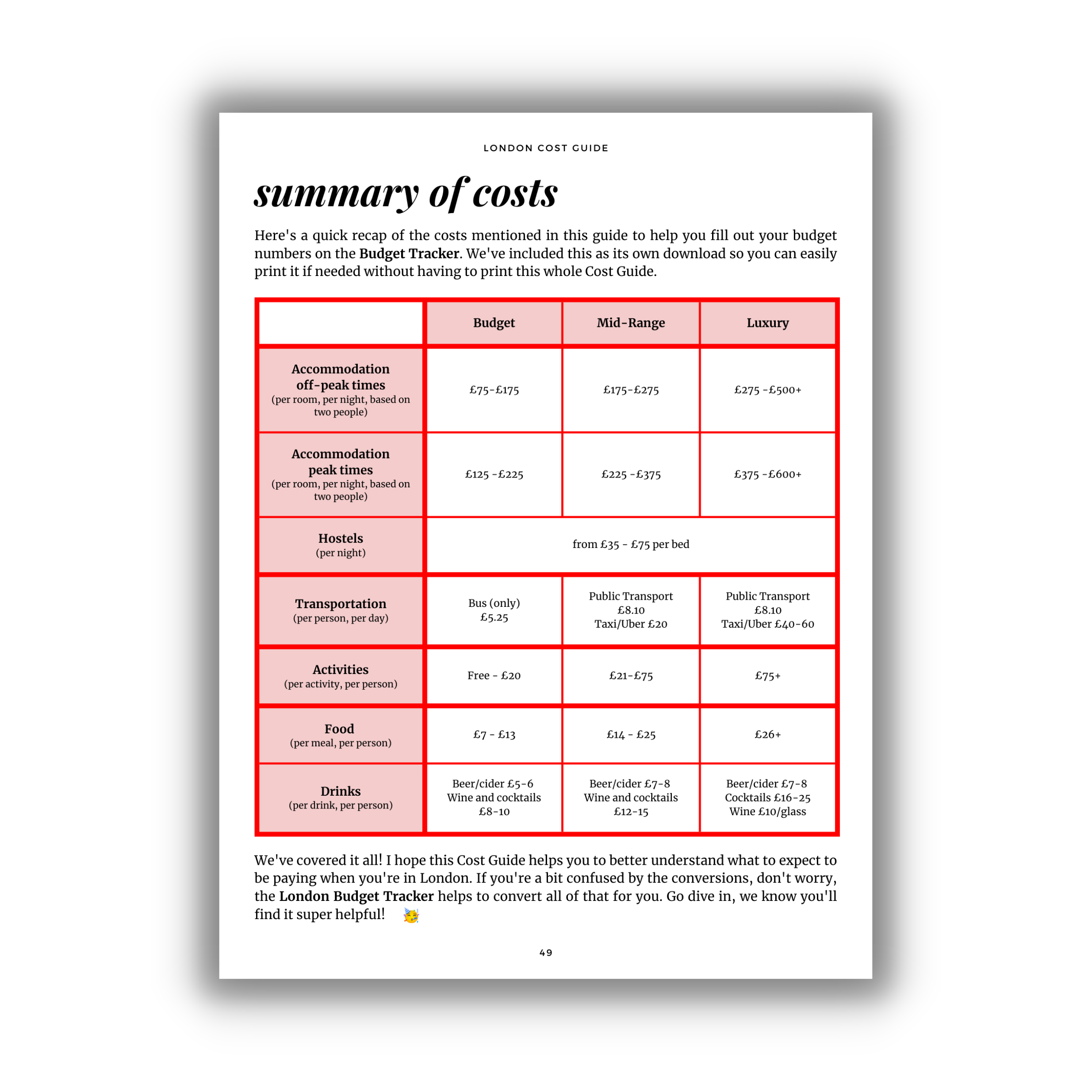
Summary of the Costs
A quick recap of the costs mentioned in this guide to help you fill out your budget numbers on the Budget Tracker .
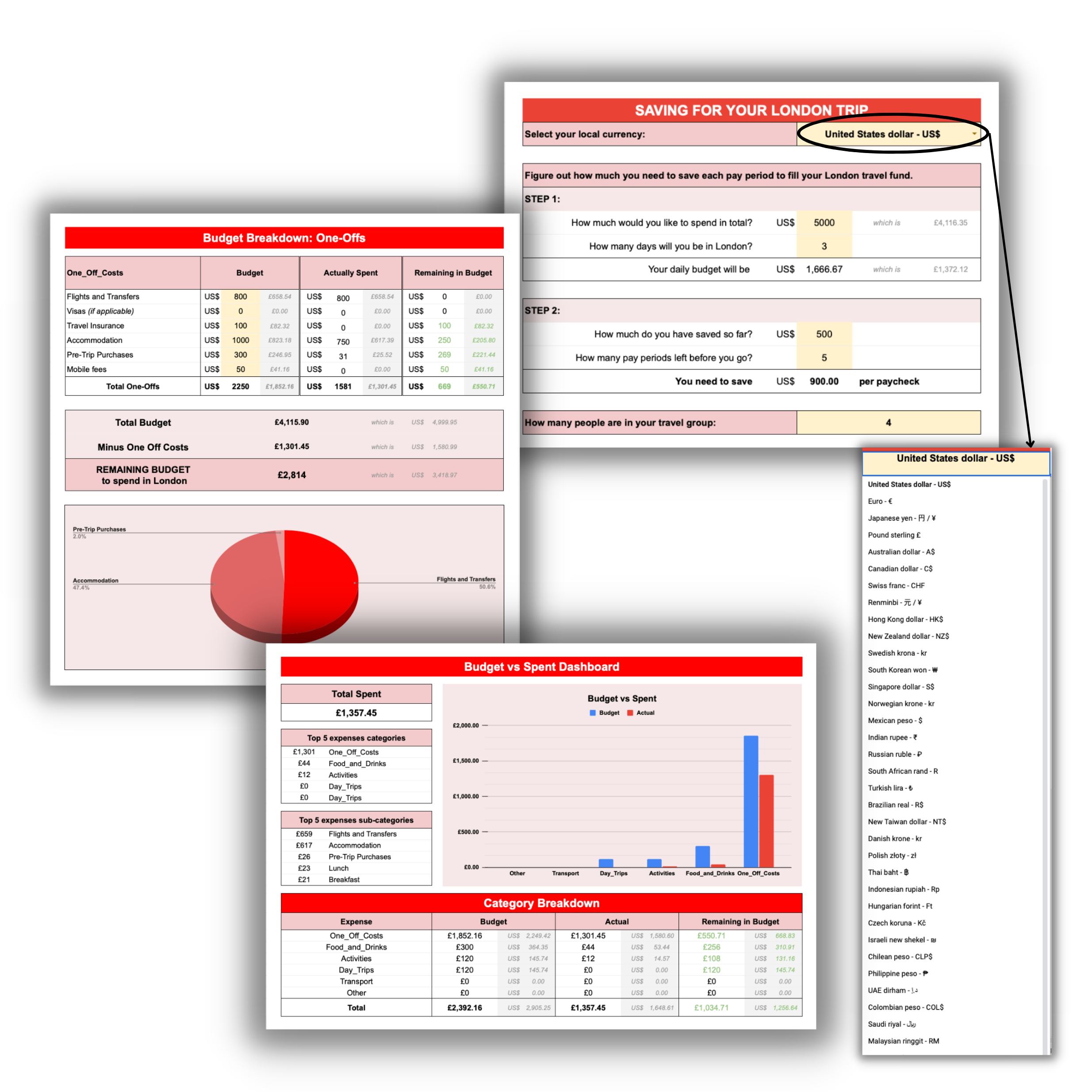
Budget Tracker
30+ currencies available!
Budget breakdown of all the costs.
Daily Spending Record
Final dashboard
See how the Budget Tracker works...
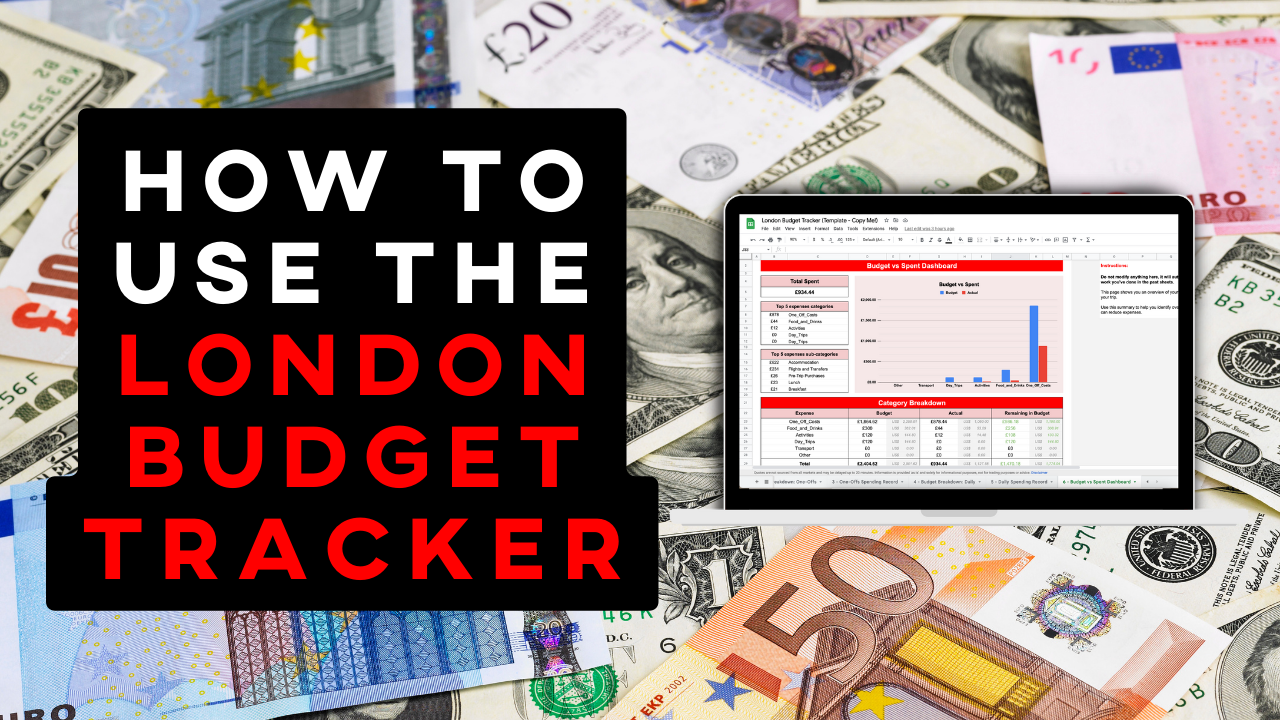
Frequently Asked Questions
How long does it take to receive the london spending guide.
You'll receive this guide immediately upon purchase via digital download. The links will be sent to your email address.
How does the London Budget Tracker work?
You'll get a link to download the Google Sheets template within your files.
We also provide you with plenty of instructions on how to use the sheet, both in the document and via a video tutorial.
How tech saavy do I need to be to use this?
You'll want to know the basics of how Google Sheets works, but otherwise we provide you with plenty of instructions and all of the formulas are protected so it's almost impossible you to mess anything up.
Of course if you have any problems or questions you can email us at [email protected] and we'd be happy to help.
Can I print the London Cost Guide?
We'd prefer if you didn't, it has lots of links in it which obviously won't work if you print it, plus it'll be a waste of paper and ink. It's designed to be used digitally so try to keep it that way :)
Do I need to have a Google account to use this?
Yes, you just need a Google Docs account via Gmail to save your file to.
Do you have recommendations in the Cost Guide for budget travelers?
Yes! We have a "budget" category for each section and we also recommend some hostels.
We're traveling as a family, does this work for us?
While the Cost Guide doesn't have a family-specific section, we included a few notes about which recommendations are kid-friendly (up to 13 years old). The Budget Tracker has a spot where you enter how many people you're traveling with and then the spreadsheet does all the math for you, when relevant.
Which currencies does this support?
It works with British Pounds (as you'll pay for most of your London things in ££) and it converts the following currencies:
United States dollar - US$ Euro - € Japanese yen - 円 / ¥ Pound sterling £ Australian dollar - A$ Canadian dollar - C$ Swiss franc - CHF Renminbi - 元 / ¥ Hong Kong dollar - HK$ New Zealand dollar - NZ$ Swedish krona - kr South Korean won - ₩ Singapore dollar - S$ Norwegian krone - kr Mexican peso - $ Indian rupee - ₹ Russian ruble - ₽ South African rand - R Turkish lira - ₺ Brazilian real - R$ New Taiwan dollar - NT$ Danish krone - kr Polish złoty - zł Thai baht - ฿ Indonesian rupiah - Rp Hungarian forint - Ft Czech koruna - Kč Israeli new shekel - ₪ Chilean peso - CLP$ Philippine peso - ₱ UAE dirham - د.إ Colombian peso - COL$ Saudi riyal - ﷼ Malaysian ringgit - RM Romanian leu - L
Customer Reviews
With so many things to see and do it was a little overwhelming. The Love and London guide has helped us tremendously.
We purchased the four day itinerary. It has been so helpful in our planning. The check lists and reminders about what needs to be booked in advance has really helped us get organized and be more relaxed! Thank you.
This guide helped us plan 5 days in London with ease. The recommendations and proximity planning really makes a world of difference for someone who is not familiar with the city at all. I would highly recommend this to anyone who's feeling overwhelmed or even just needs a little guidance on what to do and when.
I always love reading through these guides because I know they have been compiled with care by an independent expert with no agenda or sponsor.
The London Spending Guide is easy to use and a wonderful budget planner. In addition to a detailed budget calculator, it also includes a detailed expense tracking worksheet. This is very useful because, while you are on vacation, you can see when your spending exceeds budget and make adjustments. At the end of your trip, you can review your total budget versus actual spending which will help you create a better budget for future trips. I also love the trip savings plan. After you calculate your budget, the savings plan helps you determine the amount you need to set aside from each paycheck to fund your trip to London. Jess and the Love and London team did a wonderful job with this spending guide.
- Choosing a selection results in a full page refresh.
- Opens in a new window.
Let customers speak for us
The paid itinerary, in addition to the free YouTube videos from this channel (using Citymapper, transportation from the airport to Paddington, etc.) were extremely helpful. Enjoyed the mix of local gems with the more famous sites, and having the list of sites divided out in manageable groupings per day - already done for us - saved soooooo much planning time. We tried many of the restaurant recommendations - all good and aligned to the review in the itinerary. It was nice to know what to expect. The digital Google map was very nicely done. The toilet guide was a lifesaver! Highly recommend this purchase. It’s a great value considering the amount of self-research time it saved (not to mention the resident tips that couldn’t have been found easily elsewhere). :)
4-Day London Itinerary 2024
Packing Guide
Good itinerary, even better customer service!
I purchased the 6 Day Itinerary for our 10+ day trip to London in May. Guys, when I tell you these guides are lifesavers would be an understatement. If you’re like me and you get overwhelmed when planning a trip and don’t know where to start, GET THESE ITINERARIES! They take away the stress and just let you get more and more excited for your upcoming trip. I cannot thank Jess and the Love and London team enough!!

Home » Living Abroad » Moving to London » 2024 Cost of Living in London: Monthly Expenses Breakdown
2024 Cost of Living in London: Monthly Expenses Breakdown

It’s no secret that the average cost of living in London is one of the highest in the world. Before we moved here from the US, I did a ton of research on monthly expenses in London. Knowing what to budget for was so helpful, especially when it came to finding a London apartment that wouldn’t cost 70% of our salaries!
Now that we’re well past the first year living in London , I can share my insight into the various monthly costs (and a few annual ones, too). But before we get to that, here are a few things to keep in mind:
- No two people will have the same living expenses in London. If you keep your flat toasty warm in the winter and also work from home, your gas and electric bill will be far higher than a neighbor who’s gone most of the day and wears layers to keep off the chill.
- I will give a few specific examples from my own life where they make sense. But for things like rent and transportation, which vary wildly based on your neighborhood and place of work, I’ll offer ranges and links to additional London cost of living resources.
- Your monthly rent will take a huge chunk of your income. Always plan your housing budget after you’ve calculated the cost of your other monthly expenses .
- Now that the UK is no longer a member of the EU, we’re seeing price shifts in rent, groceries, and other imported goods. Coupled with the dramatic increases in energy prices and food, it’s become even more expensive to live in London vs just a few years ago.
- If you’re living in a house/flat share, remember to divide the utility costs accordingly.
That being said, here’s what you can expect in terms of monthly expenses in London.
This post contains affiliate links. As an Amazon Associate, I earn from qualifying purchases. For more information, click here .
RELATED: The Definitive Moving to London Checklist
What is the average cost of living in London per month?
Based on my personal experience, as well as data from Numbeo and Expatisan, the average cost of living in London per month in 2024 is around £1,112 for a single person–excluding rent .
While the shift to remote working and the loss of financial sector jobs due to Brexit initially drove down prices in Zone 1 and 2 London neighborhoods, those days are over. In fact, the London rental market is hotter than ever , with demand outpacing supply and properties flying off the market for over asking price.
Recent interest rate hikes and new tenant protection laws have also seen many landlords exit the market. This means there’s even more competition for the remaining rental properties, and rents have shot up further as a consequence.
As I’ve mentioned, rent is one expense that varies so wildly, it doesn’t make sense to include it in this calculation. I’ll dive more into that cost later.
If you’re moving to London with a partner, you won’t simply double that £1,112 to get your monthly spend. Why not? Because some costs won’t increase at all (ex. internet), and others will only go up by 30-40% (ex. gas).
So what is that money paying for exactly? I’ll go over each budget item in detail below. But first, I’ll tackle what’s sure to be your biggest monthly expense (because I know you’re curious).
RELATED: Moving to England From the US: 10 Tips for Americans
2024 Cost of Living in London: Monthly Expenses
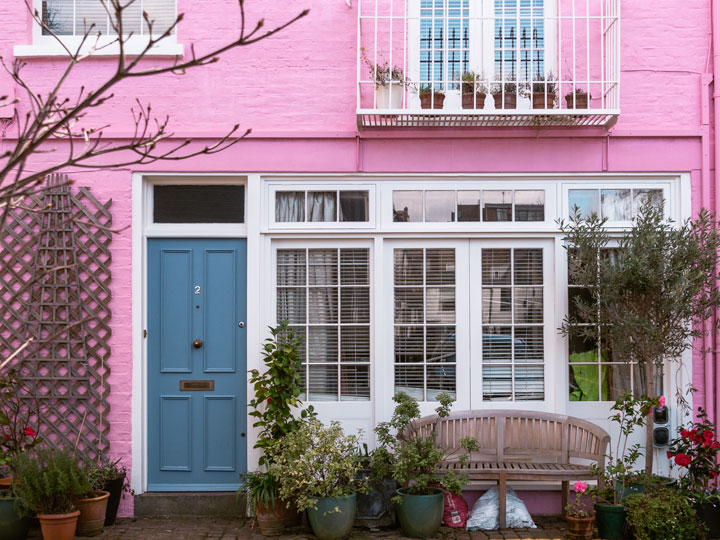
According to HomeLet, the average rent in London was £2,174 heading into 2024 . But depending on where you live in London, a one bedroom flat can cost anywhere from £1,200 to £2,000+ per month, with average prices around £1,500/month.
When you consider the average Londoner’s salary in 2024 is £42,000 (before tax), it’s no surprise that so many city dwellers end up flat sharing!
High rents are the biggest reason that London’s cost of living is so high. But it’s also the expense that’s most in your control.
You could pay £2,500/month to live in a charming one bedroom in Hampstead, or pay £800/month for a house share in Zone 3 and use the leftover money on travel/food/future savings/etc.
If you moved to London from the US , you probably heard the budgeting rule that your housing costs shouldn’t exceed 33% of your income. It’s a rule we always followed when renting and owning in the states, and it served us well.
So you can imagine our concern when we learned the average Londoner spends nearly half of their income on rent !
Unless you’re coming from a similar high cost of living area, this may come as a shock. But as long as the rental market stays hot, prices will continue to make your eyes water.
Here are some of the factors that can raise or lower your monthly rent:
- Housing type: From flat shares to three bedroom houses, you’ll find all manner of accommodation in the city. It’s obviously cheaper to rent a single room in a shared house than a studio flat in a full-service building.
- Zone: London is organized into rings of transport zones. They radiate out from central London (Zone 1) all the way to the Zone 9 suburbs. In general, the higher number zone you live in, the less you’ll pay in rent for similar properties (but your transportation costs will also go up).
- Neighborhood: Everyone wants to live in posh Kensington or trendy Shoreditch. But your money will go much farther in places like Clapham and Islington. You can check out this map of London rents to figure out what neighborhoods fit your budget.
- Proximity to a tube/train station: Landlords charge a premium for rentals within short walking distance of a station. Accepting a 15-20 minute walk to the nearest train/tube stop could save you 10% or more.
- Amenities: Things like modern kitchens, garden access, and furnishings all impact the rental rate. There were flats on my street with the same floorplan as mine, but their rent was £200 less per month because they haven’t been updated in 10 years.
Feeling overwhelmed yet?
Check out my step-by-step guide on finding a flat in London ! It covers everything from choosing the right neighborhood to negotiating rent with landlords.
Renter’s Insurance
Most London landlords will require you to take out renter’s insurance as part of your tenancy agreement. We were required to show proof of our insurance within 30 days of moving into our flat.
Renter’s insurance covers the value of your possessions, so you aren’t paying to insure the property itself. Fortunately, that makes it pretty affordable.
You can expect to pay around £10/month for a rental insurance policy. The exact amount will depend on how valuable your stuff is and whether or not you insure special items like expensive jewelry.
Note that your insurer might offer an annual payment plan instead of monthly. It’s often a little cheaper to pay the whole year in a lump sum, which is what we do.
One amazing difference between living in the US vs UK is how easy it is to compare prices on things like insurance, broadband, and energy. We used the uSwitch website to find the best deals from the service providers in our area. I highly suggest you do the same to make the most of your monthly budget.
Gas and Electric
In London, you’ll typically have your gas and electric provided by one company. And unless your place has a modern energy meter that bills by exact usage, you’ll either need to submit meter readings every few months or pay a fixed price.
If you submit regular readings, the energy company will have a better sense of how much you should pay based on your usage. This will keep you from overpaying every month and having money sitting unusued in your account, or underpaying and getting an adjustment bill.
The fixed price comes from taking the average energy cost across the calendar year and dividing it by 12. If you’ve just moved into a new place, they’ll go off of how much energy the former tenants used.
For a 1 bedroom flat, you can expect to pay around £120/month for energy from January 2024. Of course, the exact amount can vary based on if you’re in a basement/top floor flat, if your windows have double glazing, if you do a lot of cooking at home, etc.
After the doom and gloom surrounding energy price hikes in 2022-23, the cost of heating and powering our homes is thankfully starting to come down. The Ofgem price cap decreased once more at the start of 2024, which should help keep gas and electric bills more manageable.
Like many European countries, gas is much cheaper than electricity (about 3x cheaper). So an all-electric flat will have higher energy bills than a traditional gas/electric mix.
For the record, we currently pay £180/month for gas and electric in our small 3 bedroom house .
Although we work from home and cook a fair bit, we also travel a lot and have a decent amount of natural light. And I’m a bit frugal when it comes to heating the place in winter…
Also, most areas have multiple service providers for gas and electric. To help you save money living in London , go online and compare prices to see which company can get you the best deal.
RELATED: The Best Budgeting App for Expats
Most of the city is served by Thames Water, so there’s no shopping around for this monthly expense in London. There are two different kinds of water bills: metered and unmetered.
If your flat has a water meter, you’ll pay for your exact usage, plus a fixed amount for things like wastewater. If you don’t have a water meter (we don’t), you’ll pay a certain amount based on the “charge area” (i.e. borough) where you live, and the size of your property.
You can see a breakdown of costs on the Thames Water website , including the current charges for unmetered connections.
Plan to pay £20-30/month for water. If you’re on a metered connection and take lots of baths and showers, you’ll pay more accordingly.
Thames Water has a bunch of payment plans ranging from weekly to annually, so you won’t necessarily pay a bill each month. Our bill comes annually, but we set aside money each month for the day we get the yearly bill.
Save me for later!
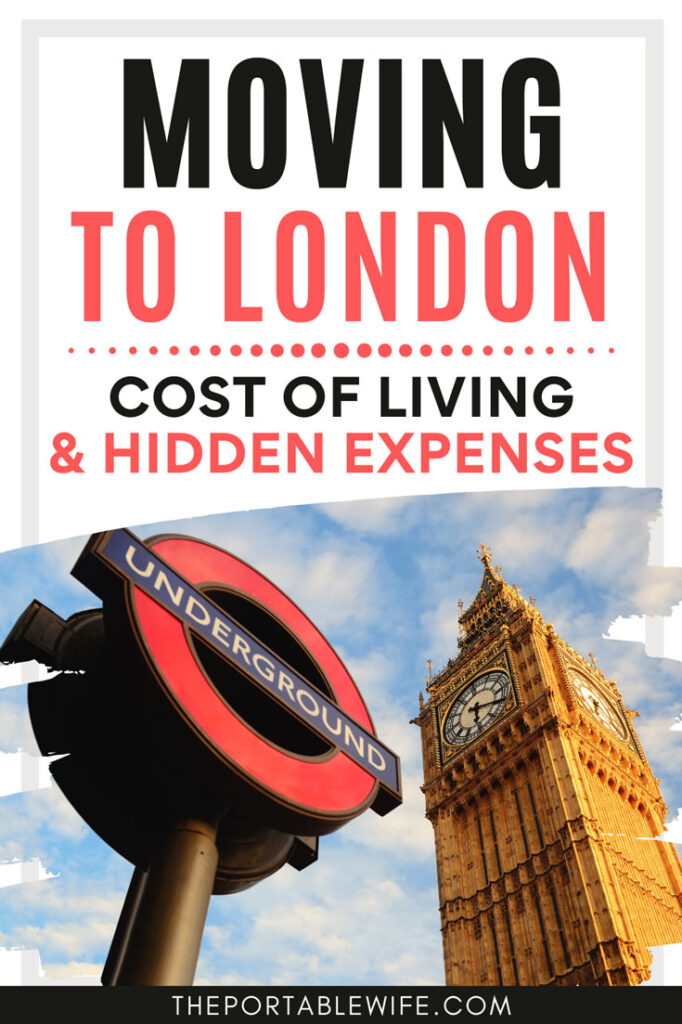
Good news: your broadband costs will be nice and predictable each month! What you pay will mainly depend on how much speed you want.
One of the pros of living in London is that most neighborhoods have multiple broadband providers. And the competition between them means you can get excellent upload and download speeds for a great price (at least compared to the US.). There are also discounts for bundling things like television and cellular service.
Our internet bill is about £41/month. We have a mid-range speed package with a minimum download speed of around 200Mbps, and it’s plenty for two people who like to game and stream in HD.
Transportation
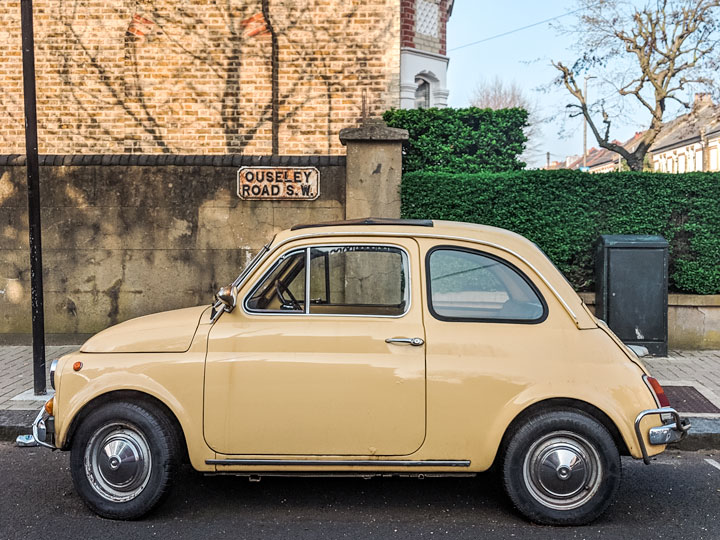
Like housing, your monthly transportation costs in London will vary greatly based on where you live. Rent may be cheaper in Zone 5 than Zone 2, but your transportation fares into central London will be almost double.
Most Londoners don’t drive. Instead, we rely on public transit to get around, whether that be the bus, tube, or train.
I could fill an entire blog post on how public transportation works in London, so I’m not going to do that here.
Just know that most people who have to travel across zones for work buy a monthly or annual travel card. Travelcards are like passes you add to your Oyster card that provide unlimited travel by bus, train, and tube within certain zones.
Just as an example: a monthly travelcard for Zones 1-3 costs £184/month in 2024. Use this handy single fare and travelcard calculator to figure out your personal monthly commute cost.
Driving in the city is a major hassle and one of the things I hate about London . Most people who live and work in London won’t need a car unless they have multiple children or need to travel the country for work.
If you only need a car for the occasional IKEA trip or holiday, it’s cheaper to rent one. Zipcar is great for single day rentals.
The competition amongst cellular services in the UK is so fierce, it’s driven prices way down. Coming from the $60 cell phone bills of the US, I was jumping for joy when I bought my UK SIM card.
I pay £15/month for 5GB of data, 1000 texts, and 500 talk minutes. I can even use my data in a bunch of European countries without paying a fee.
Many Londoners (including me) opt for pay-as-you-go plans rather than annual contracts. This gives you the freedom to switch providers whenever you want and upgrade or downgrade your services as needed.
That being said, you can get a lot more data for the same monthly price if you choose to sign a 12-month contract.
Food spending is one of those monthly expenses in London that depends heavily on your tastes and habits. If you’re hitting up the farmer’s market for organic produce every week, your grocery bill will be far higher than a thrifty shopper who gets everything from Lidl.
And if you don’t like to cook (or your flat doesn’t have much of a kitchen), you might spend most of your food money on dining out instead of groceries.
It doesn’t help that the UK’s high inflation and soaring cost of living is driven in large part by food prices, either!
Pro Expat Tip: Figuring out where to shop in London can be tricky, especially if you didn’t grow up in the UK. I wrote a detailed guide on London grocery stores to help with that! Expat.com also has a useful guide to buying food in London.
Now, I realize none of that is helpful when you’re trying to estimate your food budget in London! So let’s assume you cook most of your meals at home and bring your own lunch to work most days. And let’s also assume you shop at Sainsbury’s, a mid-range grocery store.
In this case, your monthly grocery bill for one person will be around £200-220/month. We spend around £500/month for two people who fit the description above.
Again, there are so many factors that could make this number higher or lower for you. I suggest being conservative in your initial budgeting, and tracking your grocery spending for the first few months to adjust as needed.
Dining Out and Delivery
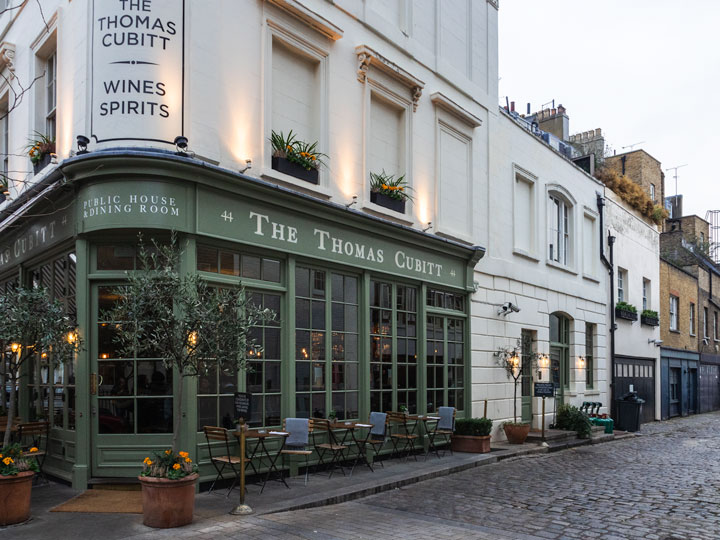
In a city with thousands of amazing restaurants and multiple delivery services, it’s easy to spend a lot in this area. As food lovers who enjoy trying new cuisines, dining out and delivery are some of our biggest drivers to the cost of living in London.
In 2024, our average food delivery order cost £35 (plus a £2 tip). We don’t dine out often, but when we do, it’s close to the £35 average cost of a mid-range meal in London.
Another sneaky cost to consider is coffee. Many Londoners grab a morning brew on their way to work, and it adds up quickly. A cappuccino from a local coffee shop will set you back about £3 to £4 depending on the place.
Instead of offering a monthly amount to budget, here’s what I suggest: look at what you currently spend in this area and add 20%.
While groceries are fairly affordable in London, restaurant prices are pretty inflated. And nowhere is this more true than drinks. It’s not uncommon to pay £6 for a pint of beer and £12 for a cocktail.
If you’re looking for delicious food that won’t break the bank, check out my guide on cheap eats in London .
Household Items
Toilet paper, cleaning supplies, laundry detergent… these are things we all have to buy but often forget to budget for!
We spend an average of £30/month on household supplies. I’ve found prices on these types of items to be comparable to the US.
Personal Care
This is one area that doesn’t have routine monthly costs. But if you’re serious about budgeting, you should be setting aside a monthly average of your annual personal care expenses.
My 2024 personal care spend averages out to £60 per month. That included haircuts, a fancy spa facial, a bit of makeup, and several nice skincare products.
Before we moved to London, I made a spreadsheet of all our hair and beauty products and estimated haircut costs in GBP. I even included an annual facial! And then I divided that number by 12 to get my average monthly personal care cost for London.
For my long thick hair, I spend around £65 on a haircut and style. My husband gets a standard men’s trim for about £35. Coming from a major US city, we spend about 10% more on haircuts in London.
Funnily enough, I stock up on most of my beauty products during our return visits to the US. But that’s only because it took me years to find products that worked for my sensitive skin, and many aren’t sold in the U.K.
Entertainment
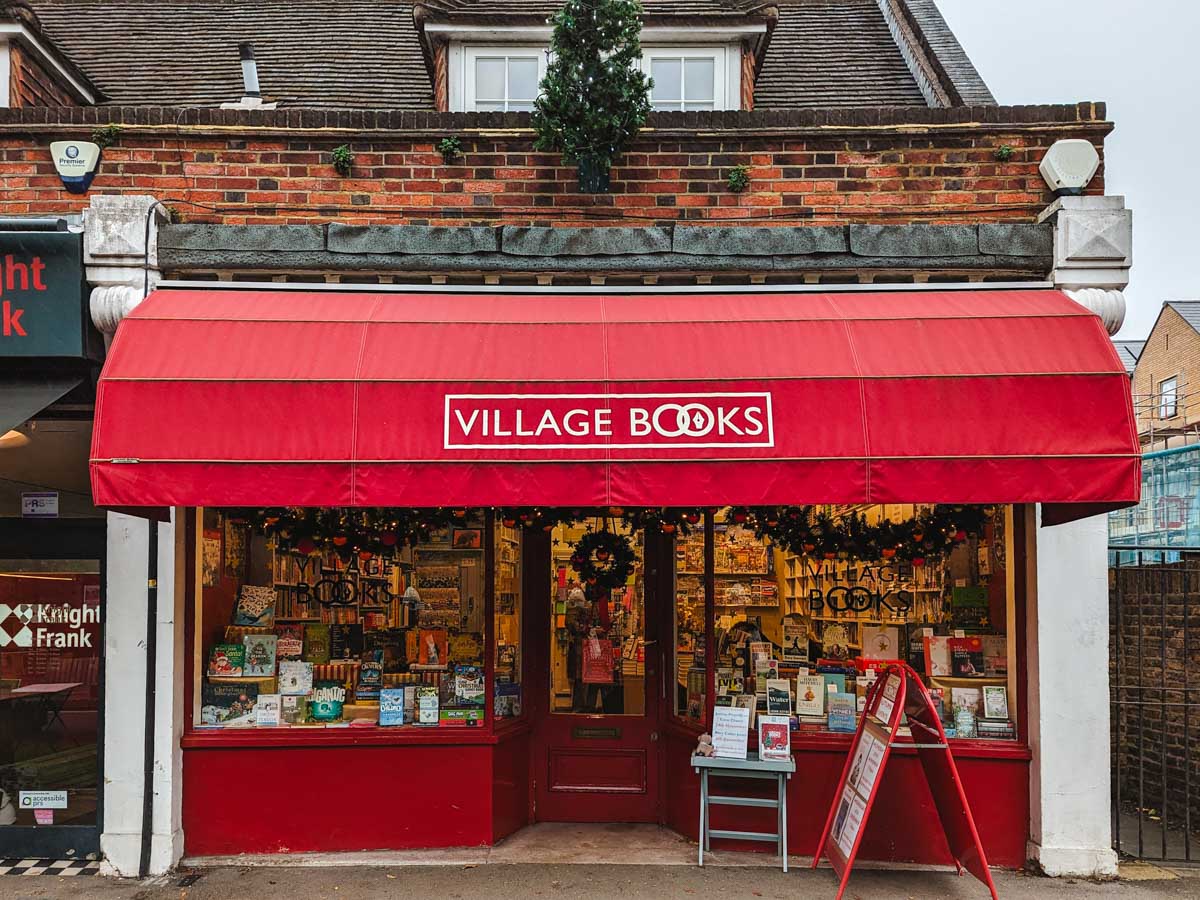
From Netflix to theatre tickets, this category is all about having fun. And we all have our own ways to spend our free time, so I can’t presume to put a number on this monthly expense.
The vast majority of our “entertainment” spend goes towards travel and books. We don’t spend much on anything else aside from the occasional video game and our streaming subscriptions.
Whatever your circumstances, be sure to budget for recurring costs : streaming services, satellite TV, video game subscriptions, etc. After that, it’s up to you.
I will say that there are tons of cheap and free things to do in London, from visiting the amazing museums to catching a comedy show at a pub. So if you’re stressing about money, know that you can find plenty of entertainment options in London that cost little to no money.
Book lovers should also check out local charity shops, particularly Oxfam, where you can pay as little as 50 pence for paperbacks.
Other Expenses
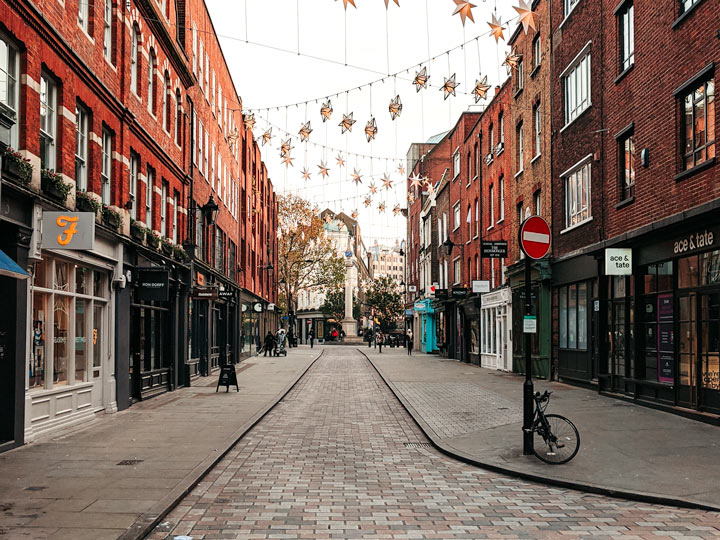
Last but certainly not least, you have the “other expenses”. For me, this includes things like pet supplies, dry cleaning, clothes shopping, gifts, and dental cleanings.
I suggest looking at your current spending in these miscellaneous areas to inform your London budget. Coming from the US, most of this stuff was comparably priced.
However, clothing in the UK is about 20% more expensive than in the US. Keep that in mind if you like to buy new clothes throughout the year!
Summary of 2024 London Living Expenses per Month
Looking for the tl;dr version of the cost of living in London? Here’s a handy reference table:
Remember: these costs are an average by month! Most people don’t spend exactly £60/month on personal care–it may be £0 for 3 months and £100 the next.
Also, you can reduce that monthly cost dramatically if you decide to flat/house share, as you’ll be saving on rent costs and splitting utilities.

Want more travel + relocation tips?
Become a member of my Patreon group for exclusive access to my resource library, including:
- Printable packing lists for moving + travel
- Money-saving tips
- Insider travel guides
- And much more
Annual Cost of Living Expenses in London
In addition to your monthly expenses in London, you’ll need to pay a few bills every year. Here’s what to expect.
Council Tax
In the UK, renters also have to pay council tax, which is like property tax. Sometimes landlords will pay it for you and just add the cost to your monthly rent. But usually, you’ll get an annual bill in the mail that you’re responsible for paying.
How much you pay depends on your borough and property value. KFH has a useful council tax tool that will show you tax bands by borough. Fortunately, students don’t have to pay council tax, and single occupants get a 25% discount.
Council tax can be very expensive, so do your research before signing a lease! We used to live in one of the cheapest council tax boroughs, and still paid over £1,000/year.
If you own a television in the UK, you are required to pay an annual television licensing fee (i.e. “telly tax”). This fee helps pay for free over-air television and services like BBC iPlayer.
Beginning April 2024, a TV license will cost £169.50/year.
This fee goes up slightly each year (usually around £1.50) to account for inflation, but the jump from 2023 to 2024 was even more dramatic due to the UK’s high inflation.
Be sure to pay your licensing fee as soon as you purchase a TV or bring one over from another country. There are hefty fines for failing to register your television.
Managing your money abroad
Readers often ask me how I move money between international bank accounts without paying huge fees. Luckily, there’s an easy and cheap solution:
Sign up for a Wise account!
I first used Wise (formerly TransferWise) when we needed to pay our London flat deposit, and it was SO much simpler and cost-effective than doing an international wire transfer from my bank. Today, I regularly use Wise to send money from my UK bank account to my US accounts.
Because I get paid in multiple currencies, I opened a Wise Multi Currency Account , which lets me send and receive money in over different 40 currencies. It even comes with a multi-currency debit card!
Open a Wise account today to get real exchange rates, speedy transfers, and ultra-low fees.
I hope this helps you calculate your monthly expenses in London!
For more relocation help, check out my in-depth moving to the UK guide .
28 thoughts on “2024 Cost of Living in London: Monthly Expenses Breakdown”
Thanks for article and valuable information, everyone should know these tips before moving to London
Happy to help, Amanda!
My daughter will be abroad for the year as a grad student. The school is located near the british museum. She is only 22. Do you think it is safe for her to live in a studio alone? And can you suggest friendly neighborhoods? Thanks so much
Hi Lisa. London is generally a very safe city, but she can always do a Google search of London crime rates by postcode to check out the areas she’s considering renting. The British Museum is very centrally located with a number of Underground line connections, so she has a big range of choices for where to live. Budget will be the biggest constraint, as even a studio apartment + bills can be £1,500/month or more.
Thank you so much.
Happy to help, Dami!
This is a great article – thanks
Glad you found it useful, Belinda!
This is so helpful! I believe it was on a different post but can you help give an idea of the real estate fee you can expect to pay when leasing an apartment?
Happy to help, Amanda! The upfront tenant fees depend on the monthly rent, but you can use these fee guidelines to calculate it. The only non-refundable fee to rent should be a max of £50, thanks to the new tenant fees ban.
Thanks so much for all your hard work in putting all this info together…such a bit of fresh air!!!!
Happy I could help, Orit!
I was just doing some future financial planning when I found this article! One of the options on the table for us in the next 10-15 years is to move to London from the US. This was super helpful for our planning – thank you for sharing this info!!
Quite accurate calculation, I have more or less the same and was struggling to find out what will be the coast of living when I was considering move to the UK. I just suggest to add 10% margin if you unsure to avoid any surprises. Great job!
Thank you , Chelsea, for this comprehensive guide ! My fiancée and I will be moving to London with the job and we have been quite rattled until I chanced upon your website. This article answers every question we had plus a few more. Deeply grateful to you for sharing these pearls of wisdom and pointing us expats in the right direction. Sincerely, SR Charles
Great article! I’m also an American expat living in zone 3 but thinking of moving to zone 2 just have better access/be in a different area…trying to figure out if the ~£500/month is worth it though. BTW if you’re still paying £15 for 5gb of data you should get a new plan. I pay £10 to giffgaff for 12gb of data and unlimited talk and text.
Great article. But I think you need to change your part about the monthly gas/electric as it is very misleading. All, (except for some very uncommon types that I have never heard of), flats/houses have a proper meter that accurately reads your gas and electric consumption. Your gas/electric company will try to put you on a monthly flat payment but this is very much an estimate and should be treated as such. You should read your gas and electric meter regularly (at least once every six months) to recalculate this monthly payment as if you don’t then you can be underpaying (bad for budgeting) or over-paying (also bad of budgeting as why should they ern interest of your money). The meters are sometimes hard to find but they can always be found and if you cannot find it then ask your landlord as I can guarantee you they know where it is! If it is locked up (it shouldn’t be) then tell your landlord you want access at least twice to read it yourself. Then call your gas electric company and update. I personally always want to be underpaying a little each month though I can understand some people might prefer to overpay to avoid surprises in budgeting. I have lost count of the amount of people who ‘think’ they are paying their electric/gas bills and all they are doing is paying a monthly estimate. They then leave their flats and either have bad debts against their record or the gas/electric companies have some of their hard earned cash and cannot find them to give it back (not that they try that hard).
Thank you for your detailed comment, Simon. You were right that my original text was unclear, so I’ve amended it. And for the record, we also submit regular meter readings (typicaly every 3 months) to ensure we aren’t overpaying or underpaying!
At last someone gets it. And gets it right ! Thank you.
This is amazing!
You’ve covered every single thing in your list. It’s super helpful, really appreciate your time:)
Thank you for your tips. This post is amazing!
Leading up to my impending move, I regularly refer to this site, so thankyou. Please, please keep us updated on the ever – changing gas and electricty bills i.e your average monthly spends. Thanks again.
Thanks Francesca! I’ve just made an update based on the increases in average rent and energy prices.
So helpful 🙂 ♡
Hello and thanks for fabulous detail !
Could you update this for energy bills for August 2022 and into early 2023 based on recent info about price caps in the Press please?
I’m curious to know how much this will cost me to live in London. Thanks for the breakdown!
I am relocating to London sooner than expected and was suddenly asked to submit my expenses estimation so that my employer could adjust my new salary. Wow! this article was extremely useful.
Thank you for putting this up to share 🙂 Greetings from Mexico
Super helpful. Thank you!
Leave a Comment Cancel reply
This site uses Akismet to reduce spam. Learn how your comment data is processed .
Money latest: The 'German classic' that's a healthier and cheaper alternative to crisps
Crisps are on the menu as we see where you can make healthier choices for the best value. Elsewhere, the boss of Sainsbury's has insisted customers like self-checkouts - do you agree? Leave your thoughts in the box below.
Friday 26 April 2024 17:00, UK
- New research reveals cost of having children
- Sainsbury's boss insists customers like self-checkouts
- FTSE 100 hits another record high
- Halifax hikes mortgage rates - as entire market moves upwards
Essential reads
- Do smart meters actually save you money?
- How to buy the least unhealthy crisps
- The world of dark tourism - what is it, is it ethical and where can you go?
- Money Problem : I have a mortgage offer - will it change now rates are rising?
- Savings Guide : Why locking into fixed-rate bond could be wise move
- Cheap Eats : Michelin chef's secret lasagne tip - and expensive ingredient you shouldn't use
Ask a question or make a comment
Private car parks are accused of "confusing drivers" after introducing a new code of conduct - despite "doing all they can" to prevent an official government version.
The code of practice launched by two industry bodies - British Parking Association and the International Parking Community - includes a ten-minute grace period for motorists to leave a car park after the parking period they paid for ends.
It also features requirements for consistent signage, a single set of rules for operators on private land and an "appeals charter".
Private parking businesses have been accused of using misleading and confusing signs, aggressive debt collection and unreasonable fees.
That comes after a government-backed code of conduct was withdrawn in June 2022, after a legal challenges by parking companies.
RAC head of policy Simon Williams said: "We're flabbergasted that the BPA and the IPC have suddenly announced plans to introduce their own private parking code after doing all they can over the last five years to prevent the official government code created by an act of Parliament coming into force.
"While there are clearly some positive elements to what the private parking industry is proposing, it conveniently avoids some of the biggest issues around caps on penalty charges and debt recovery fees which badly need to be addressed to prevent drivers being taken advantage of."
BPA chief executive Andrew Pester said: "This is a crucial milestone as we work closely with government, consumer bodies and others to deliver fairer and more consistent parking standards for motorists."
IPC chief executive Will Hurley said: "The single code will benefit all compliant motorists and will present clear consequences for those who decide to break the rules."
Sky News has learnt the owner of Superdry's flagship store is weighing up a legal challenge to a rescue plan launched by the struggling fashion retailer.
M&G, the London-listed asset manager, has engaged lawyers from Hogan Lovells to scrutinise the restructuring plan.
The move by M&G, which owns the fashion retailer's 32,000 square foot Oxford Street store, will not necessarily result in a formal legal challenge - but sources say it's possible.
Read City editor Mark Kleinman 's story here...
NatWest says its mortgage lending nearly halved at the start of the year as it retreated from parts of the market when competition among lenders stepped up.
New mortgage lending totalled £5.2bn in the first three months of 2024, the banking group has revealed, down from £9.9bn the previous year.
The group, which includes Royal Bank of Scotland and Coutts, also reported an operating pre-tax profit of £1.3bn for the first quarter, down 27% from £1.8bn the previous year.
An unexplained flow of British luxury cars into states neighbouring Russia continued into February, new data shows.
About £26m worth of British cars were exported to Azerbaijan, making the former Soviet country the 17th biggest destination for UK cars - bigger than long-established export markets such as Ireland, Portugal and Qatar.
Azerbaijan's ascent has coincided almost to the month with the imposition of sanctions on the export of cars to Russia.
Read the rest of economics and data editor Ed Conway 's analysis here...
Rishi Sunak has hailed the arrival of pay day with a reminder his government's additional National Insurance tax cut kicks in this month for the first time.
At last month's budget, the chancellor announced NI will be cut by a further 2p - so some workers will pay 8% of their earnings instead of the 12% if was before autumn.
The prime minister has repeated his claim this will be worth £900 for someone on the average UK salary.
While this additional cut - on top of the previous 2p cut in January - does equate to £900 for those on average full-time earnings of £35,000, there are two key issues with Mr Sunak's claim:
- Once the effect of all income tax changes since 2021 are taken into account, the Institute for Fiscal Studies reports an average earner will benefit from a tax cut of £340 - far less than £900;
- Moreover, anyone earning less than £26,000 or between £55,000-£131,000 will ultimately be worse off.
In short, this is because NI cuts are more than offset by other tax rises.
We explain below how this is the case...
Tax thresholds
This is partly down to tax thresholds - the amount you are allowed to earn before you start paying tax (and national insurance) and before you start paying the higher rate of tax - will remain frozen.
This means people end up paying more tax than they otherwise would, when their pay rises with inflation but the thresholds don't keep up.
This phenomenon is known as "fiscal drag" and it's often called a stealth tax because it's not as noticeable immediately in your pay packet.
That low threshold of £12,570 has been in place since April 2021.
The Office for Budget Responsibility says if it had increased with inflation it would be set at £15,220 for 2024/25.
If that were the case, workers could earn an extra £2,650 tax-free each year.
Less give, more take
Sky News analysis shows someone on £16,000 a year will pay £607 more in total - equivalent to more than three months of average household spending on food.
Their income level means national insurance savings are limited but they are paying 20% in income tax on an additional £2,650 of earnings.
In its analysis , the IFS states: "In aggregate the NICs cuts just serve to give back a portion of the money that is being taken away through other income tax and NICs changes - in particular, multi-year freezes to tax thresholds at a time of high inflation."
Overall, according to the institute, for every £1 given back to workers by the National Insurance cuts, £1.30 will have been taken away due to threshold changes between 2021 and 2024.
This rises to £1.90 in 2027.
The UK could face a shortage of cava due to a drought in the sparkling wine's Spanish heartlands.
The Penedes area of Catalonia is dealing with its worst drought on record, with vineyards across the region so parched the roots of 30-year-old vines have died.
It's left shrivelled red and green grapes languishing under intense sun, fuelled by fossil-fuel driven climate change.
Cava is an increasingly popular drink in the UK, with 17.8 million bottles sold in 2023 - an increase of 5% from the previous year, when Britons stocked up on 16.8 million bottles, according to the Cava Regulatory Board.
That makes the UK the fourth-biggest buyer, behind only the US, Belgium and Germany.
Workforce slashed
The problems have been compounded after Catalonia-based cava producer Freixenet announced it will temporarily lay off 615 workers, almost 80% of its workforce.
Under Spanish law, companies facing exceptional circumstances can lay off staff or reduce working hours.
This measure is expected to take effect from May and it is not known how long it will last.
Price rises
One industry source told retail publication The Grocer that cava shortages would push up prices "certainly for next year" if there isn't enough supply.
This could last for years if the drought persists, they added.
Consumer expert Helen Dewdney told MailOnline the staff cuts at Freixenet can only mean one thing - price rises.
However, she added, supermarkets say they are not experiencing any issues right now.
Parents are being hammered by rising childcare costs, according to a new study that suggests they may spend more than £160,000 raising their child to the age of 18.
Research by Hargreaves Lansdown has found that parents with children pay £6,969 a year more than couples without.
Over 18 years and assuming an annual inflation rate of 3%, that amounts to a whopping £163,175, the investment platform said.
Its study also found that parents were less likely to have money left at the end of the month.
Single parents carry the biggest burden, with the research suggesting they have just £85 left on average compared to £365 for couples with children.
Hargreaves Lansdown also found just 23% of single parents reported having enough emergency savings to cover at least three months' worth of essential expenses, compared to 63% of couples with children.
Parents are also at a slight disadvantage when it comes to pensions, the research found, with only 43% of couples with children on track for a moderate retirement income, compared to 47% without. Only 17% of single parents have a decent projected pension fund.
Sarah Coles, head of personal finance at the firm, said "having children is one of the most expensive decisions a person can make".
She adds that as a result of having a child, "financial resilience suffers across the board", and added: "For single parents, life is even tougher, and they face far lower resilience on almost every measure.
"It means we need all the help we can get."
By Daniel Binns, business reporter
One of the top stories shaking up the markets this morning is that UK-based mining company Anglo American has rejected a major $38.8bn (£31bn) takeover bid.
Details of the attempted buyout by Australian rival BHP emerged yesterday - sending Anglo American shares soaring.
The deal would have created the world's biggest copper mining company - with the news coming as the price of the metal hit record highs this week.
However, Anglo American has now dismissed the proposal as "opportunistic" and said BHP had undervalued the company.
Anglo's shares are slightly down by 0.8% this morning - suggesting investors may not have given up hopes that a deal could eventually be agreed.
However, overall the FTSE 100 is up around 0.4% this morning, buoyed by strong reported earnings from US tech giants Microsoft and Google owner Alphabet.
It's helped the index, of the London Stock Exchange's 100 most valuable companies, hit yet another intraday (during the day) record of 8,136 points this morning.
The winning streak comes after a week of all-time highs on the index - including a record close of 8,078 points yesterday. The score is based on a calculation of the total value of the shares on the index.
Among the companies doing well this morning is NatWest - despite the bank reporting a fall in pre-tax profits of nearly 28% for the first quarter of the year.
Shares in the lender are up more than 3% after its results were better than expected by analysts.
On the currency markets, £1 buys $1.25 US or €1.16, almost on a par with yesterday.
Meanwhile, the price of a barrel of Brent crude oil has crept up slightly to $89 (£71).
Self-checkouts - they're like marmite, people seem to either love them or hate them.
But the boss of Sainsbury's has claimed that his customers do enjoy using self-checkouts, despite criticism that that machines don't always provide the convenience promised.
Simon Roberts told The Telegraph that there are more of them in Sainsbury's stores "than a number of years ago" as shoppers like the "speedy checkout".
But despite this, he said there won't be a time when they'll replace cashiers completely.
"Over the last year, where we've put more self-checkouts in, we're always making sure that the traditional kind of belted checkout is there," he said.
His comments come after northern supermarket Booths ditched self-checkouts at all but two of its sites after customer feedback.
Walmart and Costco in the US have also scaled back on the systems.
Let us know in the comments - do you love or hate self-checkouts?
We've all heard consumer advice that's repeated so often it almost becomes cliché. So, every Friday the Money team will get to the bottom of a different "fact" and decide whether it's a myth or must.
This week it is...
'Smart meters save you money'
For this one, we've enlisted the help of Dr Steve Buckley, also known as the Energy Doctor and head of data science at Loop...
So do smart meters help you save?
"The short answer is both yes and no," Steve says.
"Installing a smart meter by itself won't magically reduce your energy consumption. But, by giving you easy access to your energy usage data, smart meters pave the way for savings that you couldn't achieve otherwise."
Before smart meters, most households only found out how much energy they had used when the bill arrived.
By that stage it's too late to address wasteful usage, leading to what's known as "bill shock".
"With a smart meter, you can see your usage and costs in real-time through an in-home display or an app provided by your supplier," Steve says.
"This immediate feedback encourages you to use less energy. If you measure it, you can control it."
In 2022, the Department for Energy Security and Net Zero found that homes with smart meters used about 3.4% less electricity and 3% less gas.
"This might not seem like a lot, but it adds up to a saving of over £50 per household annually," Steve says.
If all homes in the UK made similar cuts, that would amount to savings of around £1.5bn and a potential reduction in CO2 emissions by about 2.7m tonnes each year.
"Good for individual households but also great for the planet," Steve says.
Smart meters are often installed at no extra cost to the consumer - it's effectively free data for households.
Limitations
Smart meters are more or less what you make of them - a simple, free tool that allows you to see headline figures.
However, "without detailed analysis, it's tough to identify and eliminate" where you could be wasting money, Steve says.
Apps like Utrack, Loop and Hugo Energy can help you work out where you might be losing money by offering a more detailed breakdown if connected to your smart meter.
Those tools are often free, but you may need to register your card details as proof of address.
The tools give a number of useful insights, including looking at consumption in other households of similar size or monitoring where chunks of your money are going, such as to a faulty boiler or the "phantom load" (energy wasted by devices left on unnecessarily).
Myth or must?
Although smart meters alone don't reduce energy bills, they are a vital tool to help energy efficiency and cost savings.
By Ollie Cooper, Money team
It can be hard to balance getting nutritious foods that make you feel good without spending a lot.
In this series, which ends today after digging into yoghurt, bread, pasta, fruit juice and plant-based milk, we've tried to find the healthiest options in the supermarket for the best value.
Sunna Van Kampen, founder of Tonic Health , who went viral on social media for reviewing food in the search of healthier choices, has given his input for the past six weeks.
And for the final part of the series, we're looking at the nation's favourite snack: crisps.
The series does not aim to identify the outright healthiest option, but to help you get better nutritional value for as little money as possible.
We're a people obsessed: in the UK, we get through six billion packets of crisps a year.
Sunna has three easy tips for finding the tastiest options that are kinder to your body...
1. Understand the fat facts
"Typical crisps can be oil sponges and contain over 30% fat from low-quality vegetable oils that have been fried," Sunna says.
"What we are on the lookout for those that buck the trend and stay away from the fat."
So, he says, aim for crisps that contain less than 15% total fat.
2. Fibre up your snack time
"While crisps aren't exactly salad, some can offer more nutritional value than others," Sunna says.
"Check the labels for options that have more fibre or protein."
These help you feel fuller for longer and also keep your digestive system happy.
3. Portion control
"It's easy to demolish an entire bag in one sitting - however, many brands offer multipack bags that are portion-controlled, usually around 25g a bag," Sunna says.
Sticking to these helps to manage calorie intake and stops overindulging.
The big picture
"Small changes might not immediately seem like a lot but if you eat a bag a day with your lunch, we are talking about up to a whopping two litres of oil cut from your diet over the course of the year," Sunna says,
"This is not permission to eat crisps every day (enjoy as an occasional treat) but rather an indication of how small changes add up quickly overtime."
The good news is Sunna's recommendations are all similar in price to their popular, fattier rivals - so you don't need to make a bigger investment to reap some health benefits.
We've included the prices for the brands' standard multipacks at Tesco - correct as of time of writing.
Walkers Oven Baked - £1.95 for six-pack
"Around £1.95 for a pack of six, these crisps are baked, not fried, slashing the fat content to 13%, so a great option."
Popchips - £2.25 for five-pack
"These have just 13% fat content as they're popped rather than fried so are a great way to go reducing fat without compromising on the crunch."
And for some non-crisp options...
ProperCorn Popcorn - £2 for six-pack
Often described as "the healthier, lighter option", Sunna says ProperCorn "isn't actually the best option on the market for fat content at 17.4%".
That being said, you do get "double the fibre of standard crisps at 10.9g per 100g".
At only £2 for a pack of six, it's well-priced, too.
Snack A Jacks - £2.20 for five-pack
"At only 8.3% fat per 100g, it's a great option at £2.20 for a pack of five."
Penn State Baked Pretzels - £1.50 for 175g bag
Now for Sunna's winner.
"The German classic is a great option at only 4.6% fat per 100g," he says.
One downfall is that they are not available in portioned bags, so be careful with the whole 175g bag for £1.50.
Want another option altogether?
"If you want to be even healthier, consider the switch to nuts, seeds or even dried cheese snacks," Sunna says.
"Higher in calories yes, but higher in good healthy fats too and are more satiating which will limit the chance of overeating."
The nutritionist's view - from Dr Laura Brown , senior lecturer in nutrition, food and health sciences at Teesside University...
"Baked instead of fried crisps is definitely a way forward as well as the popcorn suggestion," she says.
"We should also be aiming to look at the amount of protein and fibre found in products. For example, lentil and pea snacks are growing in popularity due to their higher protein and fibre values, so the focus should be more on looking for ingredients other than potatoes, oil and salt.
"I also feel 'crisp' based snacks made in an air fryer are becoming more popular. These can include a wholemeal wrap with a small amount of oil added, and placed in the air fryer with paprika and other seasoning added for flavour.
"Also, chickpeas in the air fryer make for a super delicious protein and fibre rich snack. They are cheaper than crisps and lower in fat since no oil has to be added."
Read more from this series...
Halifax has become the latest major lender to up mortgage rates.
They are putting up a range of deals by 0.2%.
BM Solutions also announced increases today.
It follows similar moves by TSB, NatWest, Virgin, Barclays, Accord, Leeds Building Society, HSBC and Coventry last week.
Lenders are responding to swap rates - which dictate how much it costs to lend money - rising on the back of higher than expected US inflation data, and concerns this could delay interest rate cuts there.
US trends often materialise elsewhere - though many economists are still expecting a base rate cut from 5.25% to 5% in the UK in June.
This is what average mortgage rates look like as of today...
Justin Moy, managing director of EHF Mortgages, told Newspage: "Yet more bad news for mortgage borrowers, as two of the biggest lenders announce increases to their fixed-rate products.
"As mortgage rates creep up and past 5% even for those with the largest deposits, we seem to be lacking a clear strategy of the government or the Bank of England on how rates will eventually fall.
"Even 2% inflation may not be enough to reverse the recent trends in rates."
Be the first to get Breaking News
Install the Sky News app for free


IMAGES
VIDEO
COMMENTS
The Mayor Sadiq Khan has frozen TfL fares in London until 2025. Off-peak Friday fares. Pay as you go single fares are now off-peak all day on Fridays, on a trial basis. Single fare finder. Check the cost of a single journey between two stations. Find fares. Check the cost of your journey before you travel. Free and discounted travel. You may be ...
Overall fare. £0.00. Book train & bus tickets to London. Find fares for tube, rail and bus journeys in London. Calculate Oyster card fare costs on the London Underground, DLR, TfL Rail and National Rail train services.
Pay to drive in London; Travel tools; You are here: Home; Fares; Find fares; Tube and rail fares; Caps and Travelcard prices; Caps and Travelcard prices ... Central London Red Routes. North Circular (A406) South Circular (A205) Favourite river buses. Done updating my favourites. RB1. RB2. RB4. RB5. RB6. Woolwich Ferry.
London Trip Budget: Attractions and Day Trips. In my London budget calculator I have plugged in the current 2024 per person attraction ticket prices. Children's tickets are usually only a few pounds less. For the London Eye, for example, adult tickets are £38 and children's are £34. Not much difference.
Top Tip: An Off-Peak One Day Travelcard for zones 1-6 costs £10.40 with a Railcard. Weekly Travelcards: 2024 prices. If you stay in London for 6-7 days and use the underground, trains, and buses every day, the weekly Travelcard is the most cost-effective travel pass. The one-week pass including central London (zones 1-2) is £42.70.
TfL fares frozen until March 2025. Find out more about fares. Plan your journey across the TfL network. Journey planner for Bus, Tube, London Overground, DLR, Elizabeth line, National Rail, Tram, River Bus, IFS Cloud Cable Car, Coach.
This is an independent website that allows expert users to fully explore the single fares available when using an Oyster Card or Contactless Payment Card on rail services (i.e. London Underground, London Overground, Elizabeth Line, National Rail and Docklands Light Railway) in the London area. It can be used to get a general idea of what you ...
Average Cost to Visit London. The average price of a 7-day summer trip to London is $4,000 for a solo traveler, $5,600 for a couple, and $9,100 for a family, with the main components of cost being (1) flights, (2) hotels/accommodation, and (3) meals. In 2024, flights range from about $815 in the off-season to over $1400 during the peak, summer ...
A one month trip to London on average costs around $7,082 (£5,686) for one person and $14,165 (£11,371) for two people. The more places you visit, the higher the daily price will become due to increased transportation costs. ... and we use the data to calculate average daily travel costs for destinations around the world. We also ...
69.87 £. The overall estimate of monthly spending*. 3,824.62 £. * Our estimator doesn't include insurance, health-related expenses, parking fees, or domestic help. It doesn't take into calculations income tax. Use this tool to calculate allowance or adjustment if relocating to London, United Kingdom.
Average Daily Cost For Visiting London. It costs around £60-£95/day ($75-$115) to visit London comfortably as a budget traveler. These prices are based on what you'll need to visit the city comfortably as a budget traveler. If you want to upgrade your accommodations, add another £40-£100/night depending on your stay.
A Weekly Bus & Tram Pass costs £21.90, a Monthly Bus & Tram Pass is priced at £84.10, and an Annual Bus & Tram Pass costs £848.00. A Travelcard, which provides unlimited travel across buses, trams, tubes, and trains, can cost anywhere from £13.50 to £88.80 per week depending on the number of zones they cover.
A one month trip to the United Kingdom on average costs around $5,717 (£4,590) for one person and $11,434 (£9,179) for two people. The more places you visit, the higher the daily price will become due to increased transportation costs.
London Cost Guide- a PDF filled with advice about getting and spending money in London, plus guides for how much you can expect to pay for certain parts of your trip, and recommendations for hotels, food, drink and activities for every budget level. and . 2. London Budget Tracker- an easy-to-use but incredibly comprehensive Google Sheets template.
Flexi Season tickets are valid for 8 days of travel within a 28-day period. Please note: If you select 1 year, you are entitled to 12 tickets valid for 28 days each, as most commuters are entitled to 4 weeks of annual leave plus bank holidays. If you are travelling 3 days a week, you will need more than one Flexi Season ticket in a month.
On our website. Enter your origin and destination stations into our Season ticket Calculator. Select the start date for your Monthly Season Ticket. Tick 'Monthly' under the Ticket Options. Pick your type of traveller. Choose the class you want to travel in. Select an eligible type of Railcard*. Buy your Monthly Season Ticket.
But depending on where you live in London, a one bedroom flat can cost anywhere from £1,200 to £2,000+ per month, with average prices around £1,500/month. When you consider the average Londoner's salary in 2024 is £42,000 (before tax), it's no surprise that so many city dwellers end up flat sharing! High rents are the biggest reason ...
BUT there are lots of ways that you can reduce the cost of travelling in London, whether you are a regular commuter or you are visiting the city. First thing's first- never buy the aforementioned paper ticket! That £4.90 tube journey will cost just £2.40 for a zone 1 single journey using an Oyster card or contactless payment.
7 Day Travelcards give you seven days' travel for the price of five days. Monthly Travelcards are generally cheaper than buying four consecutive 7 Day Travelcards. They give a saving of 11% compared with continuing use of 7 Day Travelcards. For example, over a year, 12 Monthly Travelcards cost 11% less than 52 7 Day Travelcards.
By Daniel Binns, business reporter. One of the top stories shaking up the markets this morning is that UK-based mining company Anglo American has rejected a major $38.8bn (£31bn) takeover bid.
If you have a non-concessionary 11-15 Oyster photocard, you get 50% off adult fares. Pay as you go. Daily cap. 7 Day Bus & Tram Pass. Monthly Bus & Tram Pass. Annual Bus & Tram Pass. £0.85.